#since my beliefs are rooted in Japanese culture
Photo
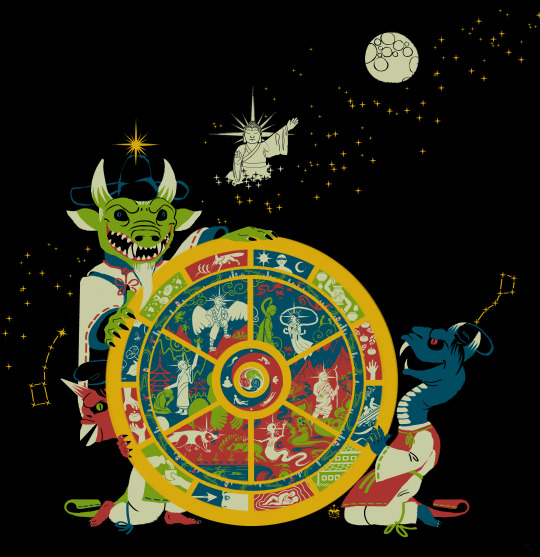
Bhavacakra with Matarakishin
This was a big project I worked on as a milestone for my studies in my faith, Shinbutsu Shuugou.
Symbolism explanation under the “readmore”
The piece uses 6 colors total: Black, white, yellow, green, red and blue. These can symbolize many things depending on the context, but here I intended for it to reference both the five hindrances + the Buddha AND the six realms.
The middle contains three animals: the snake, the boar and the bird. They represent the three poisons and are arranged in the shape of three magatama (mitsudomoe).
The first ring contains the duality of karma. This is usually depicted with a sharp border between the side where someone either falls to Hell or becomes a buddha, but I decided for the theme of this mandala to be the nonduality of opposites. For that reason both sides take on a spiraling waning and waxing shape. The figures in them are just vague silhouettes, as the concept of karma is an abstract concept that’s hard to articulate or accurately depict.
The six realms are depicted tilted. This is simply to draw more attention to the figures outside the mandala. The lower realms mainly use red and the upper ones mainly use blue (reflecting the way the karma layer’s colors are set up).
The buddha are all different beings depicted doing something benevolent instead of holding the traditional symbols buddhas hold. In each case their buddhahood is symbolized by their color (white represents buddhahood and liberation) and a star shaped halo.
Otherwise I didn’t want to depict these buddhas as perfect beings, I wanted to draw attention to the fact that the origins of dukkha can’t be exorcized, it can only be minimized and the buddha path is never complete. Parts of these buddhas extend to other realms symbolizing how buddhas can be anyone and anything anywhere.
The twelve dependent originations are abstract just like the duality of karma for the same reason. In many cases I used Japanese symbols to interpret these elements, because my faith is rooted in Japanese culture.
The wheel itself is gold, the color of earth according to wuxing. The element of earth represents dualities, the element of change and also stability, both yin and yang and all four seasons. It’s related to the figures holding/turning the wheel.
Matarakishin is a form of the kami Matarajin, a kami of, arguably, dukkha. He’s strongly connected to the element of earth, travel (be it physical or metaphorical) and is a guardian of Buddhist treasures and the Pure Land Sutra. He governs the unseen world, kakuriyo ( 隠り世 ) as a shukujin ( 宿神 ) a kami that governs fate, and with it, change. Him and his attendants represent the three poisons and are generally considered a single entity.
Faithful to traditional bhavacakras, he’s depicted fierce and horrifying as a symbol of change, same with his attendants Nishita and Teireita. Matarakishin is a green kishin (oni kami), representing greed and takes on a boar-like appearance. Between his horns is the Pole Star, a celestial body he embodies. It’s the same star used for the buddhas’ halo representing his buddha nature.
Teireita is a blue oni taking the form of a snake (representing hatred). They embody the Big Dipper, which is why the have the constellation between their horns. The final two stars connected align exactly with the Pole Star.
Nishita takes the form of a bird and is a red oni (represeinting ignorance). Their single horn point to the Little Dipper. Matarakishin stands directly above them because the Pole Star is one of the stars making up the Little Dipper.
Four of their hands hold the wheel of dharma in total, representing the four sights.
Above them, Shakyamuni Buddha can be seen pointing at the Moon, which represents liberation from dukkha. The Milky Way represents the uncountable amount of buddhas the lived, live and will live on Earth.
#my art#art by op#buddhism#buddhist art#bhavacakra#shinbutsu shuugou#tendai#contemporary buddhist art#I'm a little nervous about posting this#but I wanted to make this as like#a milestone#as to how much I learnt so far#it has unconventional elements in it#which is why idk how people who Know Things about Buddhism would react#since my beliefs are rooted in Japanese culture#but still#I really do want to share#if for nothing to see how people react
58 notes
·
View notes
Text
Okay so let's talk about some esoteric shit, the God Tree, the Infinite Tsukuyomi tree.
Some context. One can see the influence of Japanese folklores and mythology and various other belief systems/philosophies in Kishimoto's work, the way he draws inspiration from them and adorns his own story with these symbolic and narrative elements, whether it be South or East Asian philosophy (Buddhist Hinayana philosophy, Confucian philosophy, Shinto, ancient Chinese philosophy, Bushido etc). There are inspirations from Japanese mythology (Amaterasu, Tsukuyomi, Totsuka blade, Kusanagi sword) and literature, such as Chikamatsu, but also one can see the influence of modern phenomena. Art forms such as superflat art, pioneered by Takashi Murakami.

This is Murakami's art.

Or Kishi's funny little tribute to the greatest rock artist the world ever saw, Freddie Mercury. And he IS, I won't brook any arguments there.

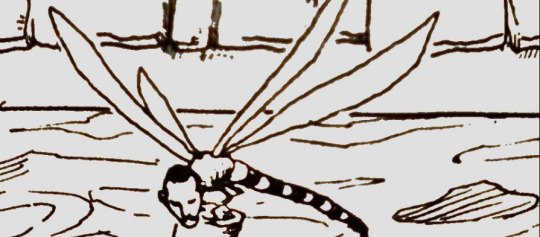
Or his tribute to the most iconic pugilist Mohammed Ali aka Cassius Clay, in the character of Killer Bee. He didn't even miss the famous line said by the man, who "Floats like a butterfly, stings like a bee."

So when I saw the God tree, I wondered if there was some context behind it that I didn't know about. I mean there's a hell lot of literature about trees and their significance in various cultures across the world. Whether it be Judeo- Christian mythology, South East Asian mythology, Germanic mythology or Celtic polytheism, Greek and Egyptian mythologies.
Japanese culture is no different, in fact they have a whole host of myths regarding trees, they have deep roots found in the concepts of both spirituality and doom, being considered indicators or harbingers of good or bad luck, fortune, having healing properties, and even for entertainment.
'Yokai' is a Japanese term that roughly translates into supernatural beings.
Yokai is a difficult term to translate into English and you will sometimes see it as demon, monster or goblin. However, yokai is much broader than that and encompass all manner of supernatural phenomena.
'Jubokko' is a kind of Yokai tree, its accounts have been recorded in Japanese folklores.
Sourced from Wikipedia :
According to folklore, Jubokko appears in former battlefields where many people have died, and its appearance does not differ that much from ordinary trees. Since it becomes a yōkai tree by sucking up large quantities of blood from the dead, it lives on human blood. When a human being happens to pass by, it supposedly captures the victim and, changing its branches into the shape of a tube, sucks the blood out of the victim. A Jubokko that sucks life out of human beings in such a way is said to always maintain a fresh appearance.
Sound familiar? We can see how Kishi might have drawn inspiration from this phenomenon, and who wouldn't, all of it sounds scrumptious. Creepy Japanese folklores and urban legends are just amazing and bone chilling to read about. Quite a lot of fun.
You know who famously contributed to Yokai art and made it really really popular in Japan?
Hokusai.
These are some of his Yokai woodblock prints.

Really, how delicious is this?
Yep, this is the same dude who created the most iconic and recognisable set of woodblock prints to come out of Japan, known all over the world as:
'Thirty six views of Mount Fuji'.
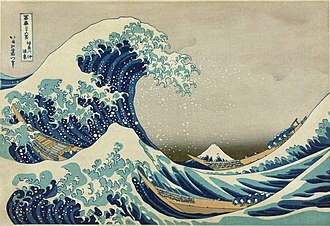
So we can certainly see the influence and the underlying concept behind Kishi's designs. And it's not just Kishimoto, other artists have also been inspired by tree folklores. Take Miyazaki in his 'My neighbour Totoro' (I can't put in words how much I love that film) wherein Totoro is depicted as a supernatural being taking the form of a camphor tree, or Princess Mononoke, the inclusion of the concept of Kodama, tree spirits that reside in special trees in ancient forests, a concept drawn from Shintoism.

However, a few days ago, I was doing a rerun of my favourite Monty Python's movies. By the way, shout out to my fellow Monty Python fans, you guys have the best taste.
So at the time, I was watching 'Life of Brian'. And guess what I found when I was watching the credit roll.
Look familiar???
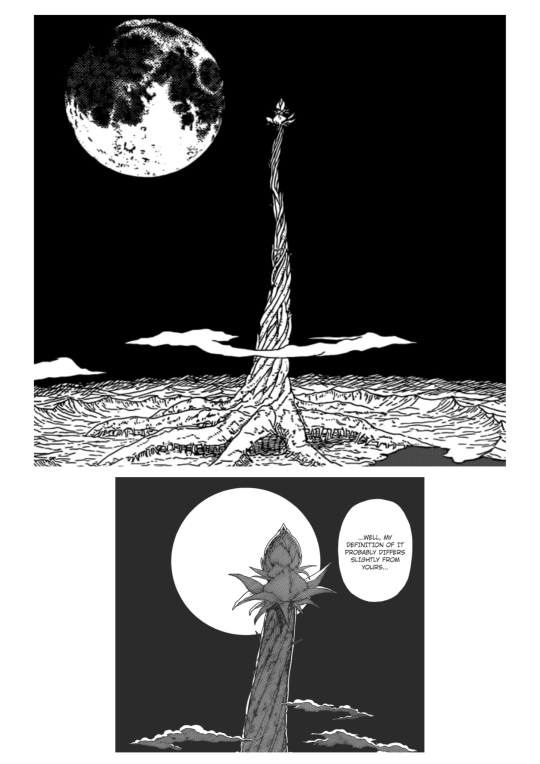
Lol.
And I was intrigued. Really Kishi? Monty Python? Seriously? You? But well, not like you haven't taken me by surprise before. And Monty Python has been seriously popular all over the world for over fifty years. But I couldn't reconcile the thought of the Japanese appreciating the kind of humor that Monty Python pushes. If you have seen Monty Python, you know what I mean. But I was again proven wrong, and I couldn't be happier about it.

Apparently, Monty Python has been so popular in Japan, even Eric Idle couldn't help showing up for it. Honestly, I am not really that surprised after all. Monty Python is awesome. Hell, if I were reeling from a devastating war, I would religiously watch Monty Python too.
Ah, Kishi, peeling off those layers in your manga, quite a task, but worth it, heh?
Monty Python's style of animation and art was quite revolutionary at the time it was first featured. It started as a placeholder back in the days when Monty Python Flying Circus was just taking flight on BBC, but look how far it has come. And aren't we all the better for it?
I could still be missing something, but the theory still seems quite plausible to me. And I doubt there will be many counter points to something like this. This is what I am going to believe nevertheless. I like it, I like it very much. Kishi, you got good taste. But well, we already knew that.
P.S. - This again goes to show how ridiculous the opinion is that a professional artist can write or draw something accidentally. NOTHING is accidental. It's just that YOU in all your ignorant ass glory don't know what lies underneath. Or overneath really, you guys are seriously lame. People who say shit like this have no idea, NONE, about the kind of effort and inspiration that goes into creating art. Like I don't know how long you are gonna delude yourself, but why cut off your nose to spite your face? Is it really worth it? Tch.
#naruto#Kishimoto#infinite tsukuyomi#monty python#hokusai#superflat#freddie mercury#miyazaki movies#mohammed ali#my neighbour totoro#princess mononoke#deidara#killer bee
105 notes
·
View notes
Text
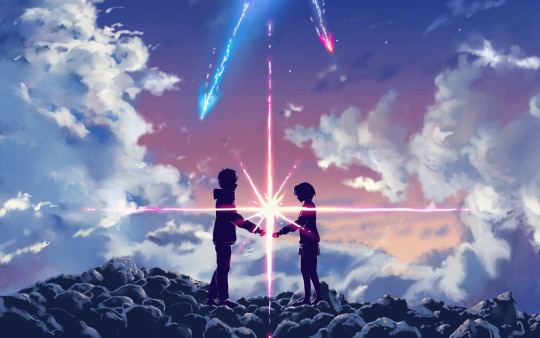
Your Name (Kimi no Na wa)
This is literally my favorite movie ever. I’ve seen it a countless number of times and can’t recommend it enough to anyone who hasn’t had this viewing pleasure. The animation looks absolutely stunning, the music is the type of beat I still hum to this day, and the characters are fun and memorable. The anime revolves around Mitsuha and Taki, two teenagers living in different towns and times who mysteriously swap bodies. They are tasked with preventing a comet disaster from occurring that would kill Mitsuha and her whole town. They prevail and eventually fall in love with each other, making for a really wholesome and fun watch. The anime talks about a vast array of themes including the possession of power, the idea of fate, modernity vs tradition, and sexuality and its connotations.
The idea of power is prevalent throughout the anime. Power is something that exists everywhere and is a force that a person can exert. With this in mind, the question becomes who holds power, or better said, who has the ability to control fate and exert a force of change? When the two main characters switch bodies, the power to control the lives of Mitsuha and Taki respectively shifts to the other protagonist. They are no longer in direct control of their lives, and are subjects to the power exerted by each other. Thinking of this idea on a larger scale, the entire cast is at the mercy of the power exerted by fate and destiny. Since Mitsuha lives in the past, fate has exerted power and control over her by controlling how she will die. It’s initially fated that her town will get destroyed. However, this power is subject to resistance in the form of Taki’s character. His determination to meet Mitsuha and save her town switches the position of power from fate/time to Taki. He, using Mitsuha’s body, helps devise a plan to save everyone. However, when he switches back to his own body and Mitsuha takes over the town’s evacuation effort, the position of power is given to Mitsuha, where she can now determine her own fate.
The idea of fate goes hand in hand with this idea of power. The red string of fate, a popular symbol for the control of one’s destiny, is a prominent theme in this movie. Mitsuha’s grandmother describes how strings represent time, how strings flow but can sometimes come undone, meet new ends, and reunite to form new threads. The idea is symbolic of destiny. Strings are the flow of time that represent the timelines in which certain events are meant to happen. However, certain “masters of fate” (string weavers) can cut the timelines, change them, and create a new future. Since Mitsuha is a string weaver, literally, she holds the power of fate. This is also symbolized with her red hair tie which is an alias for the literal red string of fate. She symbolically shares this power with Taki who is given the red string by Mitsuha. He wears fate on his hand and uses that power to change the course of history. When Mitsuha unravels her hair tie at the start of the movie, she undoes the current timeline. Taki, by wearing the hair tie, is making a new timeline by having the string meet a new end. At the end of the movie, when he gives Mitsuha her hair tie back, she wraps it around her head once more, solidifying the new flow of events.
Taki and Mitsuha contrast each other in not their bodies, but also in the locations, cultures, and ideas each character was raised in. Taki’s life is very modern and is rooted in a city where traditional beliefs are not the main focus of life. Conversely, Mitsuha lives in a rural town surrounded by nature where religious practices and traditions encompass a large facet of her life. Though the idea of a body swapping adventure sounds fantastical and nonsensical, the movie has many allusions to Japanese spirituality for its explanation of the phenomena. The movie alludes to the notion that many facets of life such as fate, time, and salvation are tied to spiritual practices and how believing and partaking in old traditions are the key to understanding and controlling such concepts. It is implied that someone living in a modern setting is devoid of such understandings of the world and thus incapable of changing the world nor their lives compared to a person of spiritual background. As a result, the movie suggests that we need tradition and spirituality in our lives in order to be true masters of our own lives. For example, Taki, in order to save Mitsuha and her village, had to commute from the city to the nature filled town out in the countryside. Once there, he was only able to get another chance to save Mitsuha by drinking sake made through traditional means in a shine.
Finally, the movie touches upon the idea of sexuality. Though I have talked about this topic a lot in the past few posts, I will say this anime has a similar mindset as other anime where it suggests that there shouldn’t be a gender norm. When each main character switches bodies, the people around Taki and Mitsuha notice how each of them act either more “masculine” or “feminine.” Their bodies act differently and show different sides of people that exist within them. Not all boys are super tough and unaccepting of emotion while not all girls are soft and frail. This show challenges the idea of conformity and encourages you to express yourself however you want. The fact that friends and families of each main character seem happy (for the most part) about their differences in behavior critiques how society should accept people who don’t conventionally fit into any preexisting mold of gender.

8 notes
·
View notes
Text
Week 1.1: Idea Generation.
Brainstorming: Tattooing and illustration
An idea that I have a lot of passion and previous experience, research, and practice in is the usage of irezumi artwork. Perhaps this could stem into an illustrative outcome that better informs tattoo getters about the kinds of tattoos that would best suit them.
The idea behind this outcome would be to help those leaning towards getting this increasingly popular tattooing style done on their bodies to understand the cultural and symbolic meaning behind their potential tattoos.
The irezumi style is consistently growing as an extremely popular tattoo style in international cultures outside of Japan, particularly western culture. However for a lot of western clients the depth of research and understanding is lacking (around the subject matter in the illustrations).
The deep personal connection that irezumi establishes with the wearer of the tattoo is one of the many reasons I am drawn to this art form. Symbolism is a massive aspect of the style. The art is meaningful and visually striking, allowing you to tell a specific story with your illustration that is rooted in extensive symbolism grounded in Japanese folklore. This significance allows design that is based in irezumi beliefs and processes to not only look good, but also mean something to the receiver. I strongly believe it is important for those who choose to get this style done to understand what their tattoo means/ would it could mean, which is the main drive behind this idea.
Perhaps this could be a publication, or a series of paintings/posters, or an infographic item, that would have descriptions and examples of the kinds of subjects you could get inked and how they can connect to your personal values and beliefs.
If my outcome is able to provide some direction and structure for those searching for this kind of tattoo piece I would be satisfied about this projects direction. It would help people to ask about and commission a more personal, unique, and meaningful tattoo that apply to their specific life experience. Tattoos are a permanent decision, especially the Irezumi style as it is almost exclusively executed as large and detailed pieces which are difficult to remove. By providing suggestions and information around personal meanings for a tattoo, we are way more likely to create a stronger bond between yourself and the tattoo you are getting done.
Design outcome ideas
- A picture book telling the story of common Irezumi symbols and their meanings. Could be an alphabet of common symbols and maybe some background on folklore and how specific Japanese creatures,
- A publication with a catalogue of tattoo ideas and how they could relate to your personal beliefs and experiences, done in a flowing and highly illustrative way. I would want the main focus to be the illustration and art style itself rather than the type.
- A series of paintings or prints that depict common illustrations in Irezumi culture. These could be part of a set that also include descriptions of their meanings and backgrounds.
Proposal
An immediate idea I had for a possible project title could be ‘The Alphabets of Irezumi’. Since this idea is like an introductory process to show tattoo clients what potential symbols they could get would mean it’ll be like showing the ‘ABC’s’ of the tattoo style.
Some Inspiration and Beginning ideas
The beginnings of a mood board. A lot of what drew me to these projects and other outcomes was the colour usage, imagery composition, and boldness. I like some of the pattern usage here and the populated imagery. If I am going to create a picture book like outcome then I want it to be vibrant and attention demanding.
Here are some imagery references that stuck out to me in my initial brainstorming and research process to generate ideas




Here are some typography based references that may provide inspiration for my design outcome moving forward. Using type and imagery together as one is something I would like to improve on and explore this semester. Being able to appropriately pair/ blend type into my illustration is something that I occasionally struggle with. Maybe experimenting with some unorthodox and new ways that I haven’t attempted before could open me up to a new perspective into this skill.
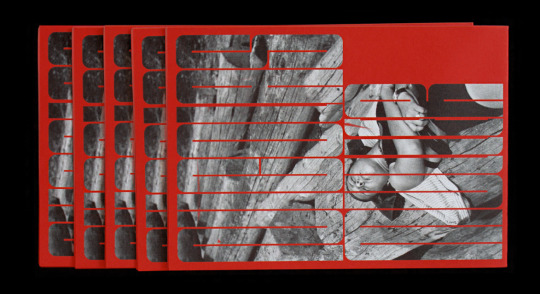





0 notes
Text
The Logics of Sessr*n: why is it successful within women?
Hi guys! Here’s the post that I promised. I will try to present some thoughts I’ve been having around the infamous ship, and some of the dynamics I think have contributed to its success. The most logical reaction would be to think that most shippers are men, since the dynamics represented do favour them, but that’s not exactly the case. Some of you have also proposed that this could be explained through self-inserting, but I would like to expand this observation a little further.
This post will be divided in sections so you guys can read the parts you find more interesting if you don’t feel like going through it all. I thought this would make it more enjoyable since it’s going to be quite long.
DISCLAIMER: I am not claiming that this is the psychological profile of the average shipper, nor do I think that this is representative of the ideology of all of them. These are just some personal thoughts and facts around some aspects that I think have contributed to its appeal. Also I apologize in advance for the quality of my expression since English is not my first language.
TW: Mentions of p*dophilia and rape.
Finally, I would like to thank @doombull for facilitating me one of the articles that I’ve used to elaborate this thoughts, and which also served as inspiration for this post.
Grab something to drink and let’s chat...
About the thrive of “Lolicon”
We are all aware that Japan does have a problem with the permissive sexualization of children.
“Lolita complex, the sexual attraction to young, pubescent girls, is woven into the fabric of everyday life in Japan. Turn on the TV and you’ll see group after group of scantily-clad teenage and preteen girls singing or dancing to music. Peek in any bookstore and you’ll find a section of photo books featuring children in swimwear. (...) During the six months from January 2016, police turned over 1,023 cases to prosecutors, compared to 637 cases for the same period in 2011 and 831 cases for the period in 2015, according to National Police Agency statistics.”
These portrayals do have impact on reality, and have been used by real life predators. Contrary to what some shippers say, there are experts in Japan speaking against this matter:
“Masahiro Morioka, a professor of philosophy and ethics at Waseda University, has delved deep into the psychology of men with Lolita complex, widely known as lolicon in Japan. (...) He says the nation’s obsession with puberty-age girls has justified sexual exploitation and crimes against them — though, of course, not everyone with Lolita complex acts on their desires and commits sex crimes. Like many people, Morioka finds the culture that tolerates lolicon problematic and wants to change it.“
Lolicon didn’t become a recognized genre until the 1970’s when fan artists depicted their favorite female characters of the time as underage girls. The reasons behind the success of this type of content is something that’s still being discussed, but some of it probably has to do with the unhealthy relationship with sexuality that some men seem to develop due to the taboo component of sex within the japanese society. Some of it might also be derived from a mismanagement of loneliness, something some of these consumers seem to struggle with. All of this is combined by some misogynistic takes on the ideal of a woman. These men find the interactions with the opposite sex to be difficult, and even menancing to their masculinity, being easier for them to project their fantasies into young girls whom are esier to shape into their needs.
Anyway, it’s not the intention of this post to really argue the reasons behind lolicon, but there’s something important to have in mind, and it’s the fact that its accessibility has made it so that there are children consuming it. Simultaneously, popularizing Lolicon is a message to girls that they are objects for consumer consumption, and that their youth (and innocence) is especially desirable in a sexual setting. This last element has definitely gotten into the way some women want to project themselves. For that matter, it’s not a surprise that some female shippers project themselves into Rin, since she’s an ideal of femininity to them.
Sources:
https://bit.ly/39QA18d
https://bit.ly/3ixPIFn
Non-offending Pedophiles | SpringerLink
Internalized misogyny:
Following the last thread, we can conclude that some girls might desire to appeal to this ideal of woman, which is absolutely normal. Gender roles are being pushed on us ever since we are kids, and it’s natural that some of them try to appeal to the male gaze in one way or another, most times even in a subconscious way. This would also explain why some shippers seem to adhere to some beliefs that have been used to justify the control over women’s sexuality.
For example, we all have seen them argue about how teenagers are more fertile and prone to survive labor. They also tend to use the “historical accuracy” argument to justify these types of portrayals. However, the imaginary of the middle ages as a place where rape and child brides where totally justified is completely modern. Sadly, these types of tropes are perpetuated by almost every historical drama, fantasy series like Game of Thrones or books like The Pillars of The Earth. It is striking how shows whose action is located in the present are reluctant to show this type of things, while when they are located in the past, they represent them in an almost sexualized way and without any scruples. Male directors do use other cultures and past times to justify this portrayals, and is something that has to be called out. How interesting is that some far right men identify themselves as vikings right? Wonder where that came from...
But why women?
After all of what I’ve said, you may think that the majority of the shippers might be men, since all of these dynamics seem to favour them. Even so, despite being a shonen manga Inuyasha had a mostly female based audience. Romance played an important part in the story, and the way it was written seemed to cater better to the preferences of girls. This is also why Sessrin is so potentially harmful… It romanticizes a relationship between a teenager and an adult in a way that’s particularly attractive to girls. We can’t lose sight of the fact that a lot of shippers probably were fans of the og series when they were young, and probably started to ship it as underage kids themselves. When they grew old, some of them left the idea of it behind but for some others it’s already deeply rooted in them.
Next I’ll explain how Sessrin it’s appealing to girls.
The polarization of masculinity and femininity: beauty and the beast
In the anime culture (and outside it) girls are represented as passive, while the male incarnates the active. Boys are the heroes, while girls are mostly portrayed as the object of desire through whatever traits the author finds the most appealing.
In the case of Sessrin we have a typical example of a contrapposition of the hyperfemenine to the hypermasculine. I have talked about this in some other posts, but in the Inuyasha lore the masculine seems to be greatly associated with the “youkai”, that tends to fall in love with a vulnerable woman. It’s also interesting to point out that female demons tend to represent traditionally negative aspects of female sexuality; they tend to lure men to their demise by their attractiveness, and also do usually have a flirty personality.
Sessrin does adjust to this type of trope that we can define as the classical beauty and the beast, not in a sense of physical attractiveness, but in the sense that it represents an aggressive masculinity that is soothed by the passive femenine. The evil spirit is incarnated by the male, while the pure girl has the role of being accepting of this nature, often changing it. This type of trope is insanely popular within women, after all, stories like Twilight and basically every other book where a normal girl falls in love with a supernatural creature seem to adjust to this dynamic to some extent. It’s the idealization of a relationship where the man is a protective figure that holds an unbelievable amount of power over their vulnerable, and often infaltilazed, female counterpart. But on the other hand, women have the ability to tame this ferocity...
What’s the appeal of the monster?
“I think with the monsters, it’s about power and danger and exoticness amped up to the Nth degree,” says Xavier. “One of the big themes in monster erotica truly is the power dynamic. The monster is big, scary, dangerous, dominating, and uses his monsterly qualities to overpower and seduce the maiden. And I think the idea of being seduced by something so wild and animal and dangerous…it’s kind of like being forced to play with fire and finding out that you enjoy it. It’s kind of this warm, fuzzy corrupted feeling.”
Interestingly enough, there have been studies on why the monster boyfriend trope is so successful. This can be somehow linked to “Teratophilia”, a term which describes the sexual attraction towards monsters or deformed people, though in this case we’ll go with the first meaning.
Among other things, it has been suggested that monsters can function as an escapist fantasy for some women, since the monster is able to embody masculine attributes without presenting itself as a man, which may embody trauma and terror in extreme cases, or aggravating patriarchal arrangements in the least.
The monster man represents masculinity through the eyes of women: it’s aggressive, unpredictable, and dominant. These stories allow them to give in into a feeling of vulnerability, they’re in control of the beast, they can even change them… It might not be a type of relationship they would desire in real life, but through these fantasies, they can experience some aspects of their sexuality and transgress the fear of man. This is very significant from a sociological point of view, these women might have been raised to desire this type of masculinity, but are aware of the threat it signifies to them. The monster guardian does protect them from the outside world, where they feel endangered, but they also are the incarnation of an “untamed masculinity” which they don’t need to fear.
All in all, Sess*in allows shippers access to this type of relationship through self inserting into Rin. However, I hope this post has managed to bring something new to the conversation. There are in my opinion more reasons why girls want to be with Sesshomaru that go beyond his attractiveness, and that may have to do with these factors…
Feel free to comment and add your opinions :)
Sources:
https://bit.ly/3o6dERh
https://tgam.ca/39ZADIS
https://bit.ly/35YH4dO
#anti sessrin#anti rinsess#anti hanyo no yashahime#anti lolicon#personal#anti-sessrin#antisessrin#anti sesshrin#yashahime
172 notes
·
View notes
Text
Michael Kaiser: Behind the Name and the Colour Blue
Part III
Ok, so we’ve arrived at the final part of my blog regarding the symbolism of Kaiser’s name: the part where I talk about how the colour “blue” is deeply connected with him and what more it can tell us about his character.
Kaiser & “Blue”
That being said, next to what I mentioned in my previous blogs on this topic, another point of interest is represented by the tattoo that Kaiser sports, which I am lead to understand is also blue in colour.
Now, it can be argued that roses too, bear a connection to the divine, as during people’s encounter with the supernatural, angels in particular, a scent of roses is sometimes said to linger in the air, while on the earthly plain, roses can be considered (and rightfully so, in my opinion) the crown of any a garden.
Blue roses, in particular, hold a special meaning, as florists across the world have dreamt of them for centuries: references have been found inside an Arabic book from the 12th century, indicating that azure blue roses were made by placing a blue dye into the bark of the roots.

Owing to the absence in nature of blue roses, these flowers have come to represent mystery and a longing for the impossible, with some cultures having the belief that the holder of a blue rose will have their wishes granted.
All of these traits have also led to blue roses being associated with royalty, possibly due in part to the idea of “the blue blood” of the nobility.
What is truly remarkable, however, is that in 2004, after years of collaboration between an Australian company, Florigene, and Japanese company, Suntory, a rose containing the blue pigment delphinidin was created by genetic engineering of a white rose.


“The first blue roses in the world were named "SUNTORY blue rose APPLAUSE," […]The applause means cheers, and the blue roses signified "dreams come true" in the language of flowers. The flowers were given this name with the hope to send cheers to many people who have made efforts to make the dreams come true.” (From https://www.suntory.com/sic/research/s_bluerose/story/

-Even so, as can be seen these roses are not completely blue, but resemble a shade closer to mauve or lavender, due to a number of different factors; still, the dream to create a perfectly blue rose has not ceased and is being pursued by those passionate in the field. Not that even this colour doesn’t fit the narative, since purple is a colour that has long been associated with royalty.-
Next to the above link, more of the information found here was found at Wikipedia: https://en.m.wikipedia.org/wiki/Blue_rose.
Well, this has been it for my blog on this topic. I hope anyone who’s come across it has enjoyed reading it and found some food for thought in the information provided here. Thank you for going on this brief journey with me into the symbolism behind this character’s name and his connection to the colour blue.
#blue lock#bllk#bllk kaiser#blue lock kaiser#michael kaiser#kaiser michael#blue lock kaiser michael#bllk kaiser michael#blue lock michael kaiser#bllk michael kaiser
15 notes
·
View notes
Note
Is there any difference between an Akuma and Oni in general? Like is the term Akuma/Oni refer specifically to a certain demon or just a broad term for demons or devils in Japanese terms? Thanks for answering!
The Difference Between Akuma (悪魔) and Oni (鬼)
As a disclaimer here, I only have a hobbyist interest in this, so am doing my own research and am not an authority on these topics! I also am a beginner at Japanese and have only been teaching myself for a couple of years. I'm also going to be answering this with some references to Tekken, apologies if that wasn't originally intended in the ask - I mostly just point out some places where the words are used in the games.
First though, just from looking at the kanji we can already see some interesting stuff-
悪魔 - akuma. The first kanji is 'evil' (悪) (read "waru" on its own, but "aku" in this compound, familiar to Samurai Jack fans). If you're a King fan, you'll recognise it from the back of his Tekken 3 t-shirt. The second kanji "ma" (魔) contains the kanji for 'oni'. Written like this it also means demon and is the compound that goes in lots if other words. It's also the kanji that goes in sorcery/magic (it's used in Claudio's Sirius Style Exorcism Sorcery), and whilst it seems to have negative connotations in most of the words I can see in the dictionary, it does have the qualifier "evil" here presumeably for a reason, either to strengthen the implication or clarify it.
鬼 - oni. You can see it in the akuma kanji, under the 2 little trees in the second kanji. This also means demon, but in a much more obvious way.
The two are used interchangeably, but one example of a differences is that 'akuma' is used to refer to the devil in faiths where there is a figure like Satan. The katakana is also sometimes used for Satan or 'devil' (the latter being used for Devil, the entity inhabiting Jin and Kazuya in Tekken).
Here is a (not great) google translate of part of the Japanese wikipedia page on akuma. I have put back in the relevant kanji for clarity:
The devil (Akuma) is a word that expresses an evil supernatural being rooted in a particular religious culture or a transcendental being that symbolizes evil.
In Buddhism, the devil means a demon that interferes with Buddhism, and is also regarded as a worldly desire. In Christianity, it refers to Satan and is considered to be a seducer of human beings who attempts to desecrate God. Evil spirits [悪霊|akuryō] (demons [デーモン] ) in Western culture other than Satan are also generally called demons [悪魔|akuma] in modern Japanese. In Islam, the devil [悪魔] is called the Shaitan, Iblis.
Depending on the religion, it refers to something that is hostile to the gods, and is also a derogatory term for gods of other religions.
The Devil in Japanese
The Chinese word "devil" [悪魔] is originally a Buddhist word derived from the Chinese translation of Buddhist scriptures, but in modern Japanese it is also used as a translation of Western Satan [サタン] , Devil [デビル] , and Demon [デーモン]. Habian's "Uko Hajime" shows examples of Christian translations of Christian demons such as "Jabo" (transliteration of Portuguese Diabo), "devil" [悪魔|akuma] , "tengu" [天狗], and "demon" [鬼物|onimono].
Devil as a Buddhist word is synonymous with the transliteration "Mara" [魔羅] and "Ma" [魔] of the Sanskrit Mara [マーラ]. The Chinese character "demon" [魔] is a combination of the note "oni" [鬼], which refers to the dead and implies a supernatural thing, and the note "hemp" [麻], which represents the sound of mara.
According to Tang Zhanran, what used to be written as "Ma" [磨] has been written as "demon" [魔] since the Emperor Wu of Liang. ("Saikansuke Yukiden Hirosetsu": "Old translation of the theory of magical characters" ). This is a myth that is also written in the Kangxi dictionary, but there are archaeological sources that include the character "Ma" [魔], which is presumed to have been copied before the Emperor Wu of Liang. In Japanese folk beliefs, things that are supposed to cause disaster have come to be vaguely anthropomorphically called "devils" (悪魔|akuma).
By comparison, on the oni wikipedia page, it suggests 'demon' or 'ghost' as the best translation, and states that "Oni is a legendary being who is generally considered to be a Japanese youkai. It often appears in folk tales and local beliefs." Oni have a clear place in Buddhist reincarnation too, being a stage of the human soul after death. It is possible to turn in to an oni. Oni are also sometimes used when translating western terms such as trolls or fairies, so you get a sense of their more ambiguous moral neutrality here.
On google there are 630 million hits for oni and 142 million for akuma, so the former is definitely more in usage, probably because of its more generic catch all connotations. On some Japanese websites where Japanese people are asking for the difference between oni and akuma, other Japanese people have suggested that the main difference is the moral ambiguity of 'oni' which are not always evil (as in my last post on oni) (they also point out the role they play in Buddhism), whilst akuma to them has more connotations with the Western devil and is a purely malignant figure. Another Japanese person says that whilst oni might be sent out to hunt down fallen humans, they are commanded to do so, so it is just the role they have and part of their nature, rather than Western 'akuma' (devils) who seem to do this of their own accord as truly evil beings in themselves. So it seems like oni in Buddhist mythology are kind of neutral gatekeepers - bureaucrats of the underworld, rather than beings necessarily of evil. Another person points out that in Japanese Buddhism, reincarnation means that your soul will eventually return to this world, so the time in hell is one of rehabilitation. Oni are like rehabilitation officers and not fundamentally evil. A devil 'akuma' by compariosn is not sympathetic to humans and has no mercy for them.

All the images on the Japanese wikipedia page for 'akuma' are western demons and devils. Above is Michaelangelo's 'The Torment of Saint Anthony', the main image that has been chosen.

The blue-skinned horned oni of Japanese mythology is the image used on the ‘oni’ Japanese wikipedia page. Above is main image, Soga Shohaku's "Yukiyama Dojizu".
So the short answer is yes they are interchangeable, and both oni and akuma are used in some more generic capacities. However, they both have more specific connotations within their meaning too, where oni implies a category of demon from Buddhism that is involved in the more morally neutral rehabilitation of human souls, whilst an akuma (now) conveys a malevolent being, a devil, which is largely absent from Buddhism and more directly brings to (the modern Japanese) mind the Western 'Devil'.
6 notes
·
View notes
Text
300 followers special: debunking Arahabaki
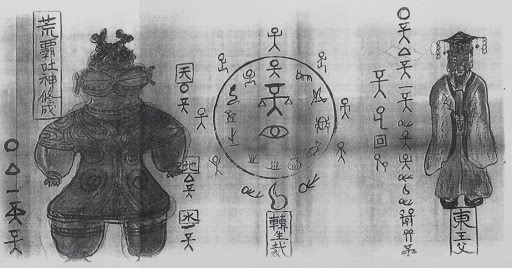
Arahabaki is a mythical figure with a relatively large popculture footprint, mostly thanks to Shin Megami Tensei, but little to no source material to go with it. For this reason, especially in english-speaking spheres, many claims rooted in pseudohistory and hoaxes, such as the image above, circulate uninterrupted. Under the cut, I will attempt to debunk their source. If stories about dogu, piss bottles and improbable journeys to Ecuador interest you, you found the right place.
The claims of Arahabaki's antiquity and in particular associating this obscure deity with dogu – specifically the shakoki dogu - all go back to Tsugaru Soto Sangunshi (I will refer to it as TSS in the rest of this article) and other associated writings, so called ”Wada family documents,” all of them written by a certain Kihachiro Wada. It's a series of forgeries created in the 1970s (with additional works produced through the rest of Wada's life – he passed away in 1999), which in addition to presenting a fictional history of the Tohoku region, centered around a fictional local kingdom, also mention Mayan prophecies, Nostradamus, Mu, and various scientific concepts, usually misunderstood by the author.
To my knowledge, TSS is only covered in one english language source, which is horrid and basically unusable - The Sacred Science of Ancient Japan: Lost Chronicles of the Age of the Gods by Avery Morrow, which does present the truth - eg. that it's a forgery - but then the author gets caught up in some sort of Evola-influenced spiritual doctrine which makes him claim that perhaps it's an echo of some "spiritual truth" or something along these lines, which is obviously not a sound argument from the perspective of anyone with even just a passing interest in history. Social sciences are still sciences, not religions.
TSS claims shakoki dogu represent an “outlawed” god formerly worshiped by people inhabiting Tohoku, whose name was also their endonym. It doesn't delve deeper into the history of Jomon art, and doesn't acknowledge dogu other than shakoki – considering not all dogu found in the Tohoku region (or even further north) belong to this category, it potentially makes it possible Wada was simply familiar with von Daniken’s confabulations and had no other exposure to jomon art; I have not seen this possibility in any japanese debunking articles, though. It's additionally worth noting here that while the exact purpose of dogu remains unknown up to this day, they're neither a taboo (indeed, many towns use peculiar locally excavated dogu as mascots nowadays, like Ravi from Minami Alps), nor particularly rare – estimatesof the number known today vary between 15000 (National Museum of Japanese History estimate) - 18000 (estimate from this article). The majority are of course not shakoki dogu; the difference between various estimates likely comes from different approach to counting figures only known from fragments.
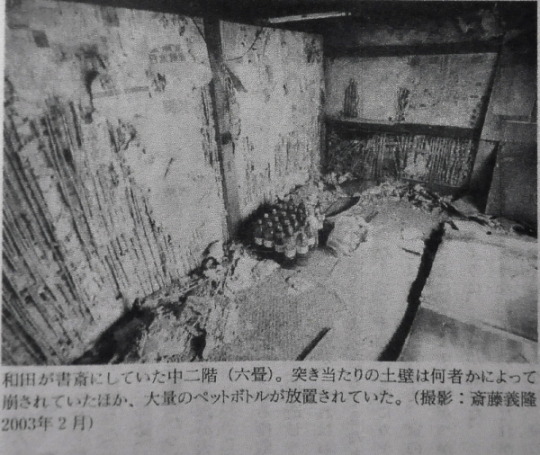
Wada claimed that he merely discovered TSS, rather than wrote it – according to his account, a case of old documents fell from the ceiling while his house was being renovated in 1948. Supposedly, the discovery – so called “Kansei original” - was compiled between 1789 to 1822, and then copied between 1870 and 1910. Wada later claimed he lost the original, but based on gathered evidence it seems obvious it never existed. Various pages known to researchers, purported to come from the original, the Taisho copy, and writing Wada confirmed to be his own, are written in the same style, and with the same mistakes. Additionally, as a visit made in the house by a debunker at the request of Wada's cousin, who appears to be its owner currently, confirmed it's virtually impossible that a large number of documents could have been stored above the ceiling; it has also been called into question if the house existed before 1950. What the visit did reveal was a large number of plastic bottles containing human urine, left undistrubed since the 1990s. A relatively unsophisticated way to make paper appear older than it is requires soaking it in urine, and this rather offputting find has proven that this was Wada's preferred method of making his writing appear older than it is to onlookers, especially these lacking formal experience with antiquities.
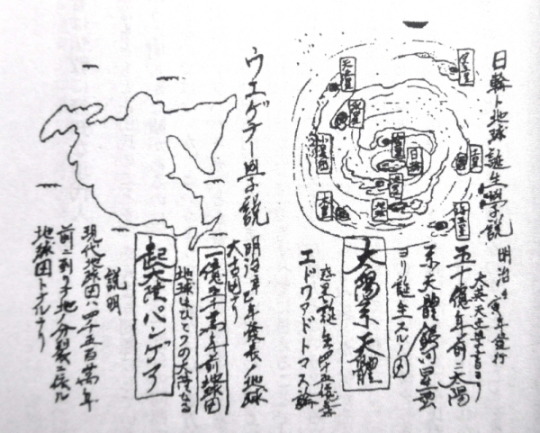
Truth to be told, even without the grand urine discovery, TSS was not difficult to discard as a forgery. As I mentioned above, its particular weakness are bizarre references to scientific concepts and discoveries, revealing a low level of historical awareness of the author – for example, references are made to quasars, continental drift theory and Pluto – discoveries not yet made in the suggested eras; to make it more embarrassing, TSS claims it was based on foreign sources which weren't yet published at the listed dates. It also references natural disasters which never happened, and urban legends and folklore which only developed recently, like the claims about Jesus' grave being located in Aomori prefecture, which only date back to the 1930s (Wada's documents claimed it was a story already known in the Kansei period, in the 1790s...). On top of all of this, a number of purported authentic illustrations were simply traced from contemporary sources:
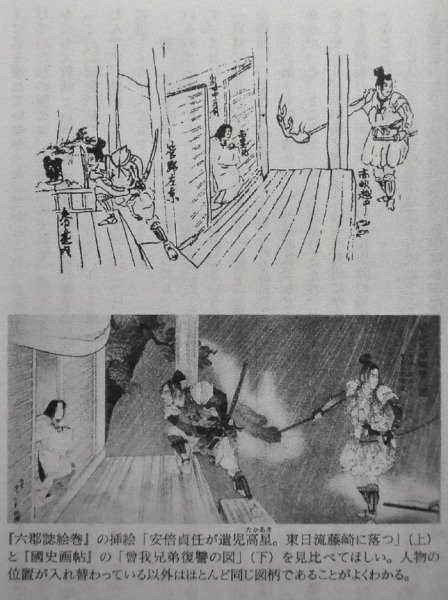
It's worth noting that TSS wasn't the only fraud Wada was involved in, as we can learn from his wikipedia biography he fraudulently claimed to be a former Imperial Palace escort officer before embarking on his adventure with crafting false chronicles soaked in urine.
Tragically, TSS found supporters not only among the expected crowd of various wannabe occultists, frauds and naive teenagers, but also among a number of genuine historians, most notably Takehiko Furuta. It would appear that he became interested in it in hopes of finding support for his theories about Japan originally having more than one ruling family, but with time he fully embraced it, and actively advocated the bizarre visions it contained. A particularly outlandish claim of his was insisting that Meiji era educator and political activist Fukuzawa Yukichi quoted TSS in his work (the quote in mention appears to be a paraphrase from american declaration of independence).
It's worth noting that while Furuta seemingly was a genuinely accomplished scholar of Shinran doctrine, supporting TSS was far from his only adventure with pseudohistory. He was also a staunch believer in the long discredited claims about links between japanese Jomon culture and the Valvidia culture of Ecuador, claiming that various references to fantastical lands lying between China and Japan or beyond Japan prove that the Japanese reached America in ancient times (you can torment yourself with one of such articles here). This theory was briefly advocated by a number of American scholars before him, but obviously has no support today. It's nothing but a new take on XVIIIth century French claims about present day British Columbia being the Fusang described in some Chinese texts. Sometimes strange lands and creatures at the edge of the map are nothing more but fantasy.
Furuta's particularly shameful contribution to TSS discourse was declaring that undermining its authenticity is rooted in historical prejudice against the inhabitants of Tohoku and Hokkaido. Personally I'm under the impression that discarding an entire region's real, very complex history in favor of fanciful hoaxes is much more likely to be rooted in such prejudice. The claim Arahabaki was an Ainu kamuy, common online, appears to come from a similar place – I will not examine it here, but I find attempts to shield forgeries from criticism by attaching them to poorly documented and historically suppressed beliefs of historically persecuted groups to be even more disgusting than regular fraud of this sort.
What Arahabaki actually is? This is difficult for me to tell for sure, but certainly nothing out of ordinary - not a dogu, and not the main figure of some lost fabulous country. There is a number of mundane temples enshrining Arahabaki, for example here. This article also mentions a number of mundane locations enshrining Arahabaki today; curiously, many of them are located outside Tohoku. A number of theories exist, linking Arahabaki to the usual suspects: religious beliefs of the Emishi people, who originally inhabited Tohoku, and may or may not be one and the same as ancestors of present day Ainu; snake worship; ironworking traditions; marebito beliefs; gods enshrined in freshly established fortresses... Whatever the truth is, it will inevitably turn out to be more interesting than hoaxes, as study of history generally proves.
279 notes
·
View notes
Text
i look at the withered flower and smiled
Mild spoiler for the Japanese film "I Fell in Love Like a Flower Bouquet".
I like tragedies, but I don't like it when they happen to me. I mean, who would? It's a perfectly normal and reasonable preference. Yet, the Japanese film "I Fell in Love Like a Flower Bouquet" encourages me to view tragedies differently.
It's not that the movie teaches me a completely new lesson. More like it reminds me what is life.

("I Fell in Love Like a Flower Bouquet" Movie Poster)
The story is simple: a boy and a girl, both have particular tastes in art and culture, feel disconnected from the people around them until they meet each other. It is as if fate is waiting for them to meet and they are destined to be with each other, as they quickly realize they share similar preferences and values. They embark on a relationship and seek to live against the norm, yet the reality of the capitalist society eventually becomes hard to ignore and they have to decide on what sort of person they wish to become, and where exactly is their relationship going.
The story itself is predictable. What makes the film so memorable to many is its commentary on this generation's youths, youngsters who wish to live a so-called "cultured" life in a capitalist world. But in its core, the themes aren't new: the reality of adulthood can easily kill our youthful dreams, how idealism cannot take root and pursuing it in the real world does not end well, how good things never last forever. These aren't new ideas. I like the simplicity of the plot, the music, and the mood of the film, but its message isn't groundbreaking.
Yet I still cried near the end. I guess this is a sign that I'm still young. I still dream and I still wish my dreams can one day come true. I still wish there is a chance where I don't need to compromise with reality. So when the film shows how such belief is a sign of naivety, the realization still crushes me.
That's not how the film ends though. Spoiler alert. The ending is not sad. Oh, no, I mean they broke up - that is not really a spoiler, since it is stately clearly at the beginning of the film and hinted in the trailer - but it's a happy ending.
Oh yes, our youthful passion cannot last and reality is cruel, but who says we cannot look back at our younger days and smile at what we lost? A flower may bloom in spring and wither in winter. But that's how a flower "live". We cannot change its nature but it doesn't mean a withered flower is not worth smiling at.
All that is beautiful may fade, but it doesn't lessen its beauty. I guess we need to be reminded of that.
6 notes
·
View notes
Text
My honest honest opinion on second citadel season 3
Uhhhh... short answer? I didn’t like it much.
Okay wait before I go on to my long answer I need to say that this is all just my opinion and it’s all subjective. If you liked sc season 3 that’s awesome! I get why you do and I’m glad you enjoyed it!
But I really wasn’t a fan of where they went with it (even from episode 1), and I’m gonna go on a long rambly and repetitive rant about it.
I’m not gonna talk about the way the season ended and the setup for s4 because I haven’t fully formed my opinion about that - to form my opinion means to relisten to the season and i don’t really feel like doing that.
Anyways, these are my unfiltered 2am thoughts about the Rest Of It - maybe I’ll neaten it up later to make it more palatable but for now it’s wordy n messy and you can just. Not read it bc it’ll probably make you mad, or feel free to pick it apart and tell me I’m wrong, or unfollow me (and at least one person has already done so lmao) but like that won’t change the fact that I just wasn’t feeling s3 so uh. That said.
Long answer? I love the second citadel... at least the first two seasons
I love the world building, how the setting is such a unique, deliberate step away from eurocentric fantasy, how refreshing all that is! The Second Citadel (the place) is rich with culture and history from the brief glimpses we get of it (mostly in knight of the crown). Not to mention the monster society, with its own rules (or lack thereof) and environments and personalities.
I love the storytelling, how different mediums are woven into the way each episode is formatted. Rilla has her tape recorder, Damien his prayers, Caroline her letters, and each medium is so well suited to each character, and it truly lets us get a glimpse of what’s going on in their minds, and I find it utterly fascinating how a protagonist of one story could just as easily become an antagonist (or at least, an annoyance) in another
And the characters! Each one so compelling, with their own goals and motivations, their own intriguing backstories and potential.
Most importantly, the way these characters play off of each other is what makes second citadel amazing. Getting to see people with similar experiences but different world views clash (Caroline and Mira), people with fundamentally different beliefs reconcile and meet in the middle (rilla and arum), just, Kabert created so many interesting characters, and watching them bounce off one another is a joy.
And that’s what made season 2 so great for me. The exploration of each character, getting to see their good sides and bad, through either a medium tailored for them, or through interactions with others, as they explored a fascinating world.
The end of season 2 left me so satisfied, but still with so many questions and excitement about what was to come. I wanted to see Talfryn come into his own and step out of his brothers shadow. I wanted to see Damien, Arum and Rilla navigating their new relationship. I wanted to know more of the fate of Rilla’s parents, Damien’s past, the consequences Arum would surely face after defying the monster court. I wanted Marc to finally be recognized by his fellow knights, to watch as Caroline lead the journeymen knights, while learning to trust in others as she was beginning to do. I wanted Angelo continuing to unlearn the implicit biases that had been instilled in him as a result of his upbringing, or more details on Caroline and Quanyii’s relationship. I was also curious!! How would human and monster relations change after the events of the finale? And would we learn more of the past, when humans and monsters lived together in peace?
I was buzzing with excitement for season 3, and then.. it came, it aired, and then it went.
And I felt... meh?
Don’t get me wrong. There were moments that I liked. Some of what I hoped to see did happen (see the above paragraph lmao), getting a glimpse of the western wastes with its own culture a joy. The dynamics between Olala and some of the characters were really fun! And the direction the story took at the end was one I didn’t expect, but left me open to more.
That said,,, everything else about the season just. Didnt gel with me.
Everything I loved about second citadel pretty much wasn’t there??? Aside from Caroline, Angelo and Quanyii, all the characters they spent so much time introducing to us and fleshing out over 2 seasons were just relegated to the side??
I think my main problem with season 3 was that it felt like a completely different show. Characters introduced as part of an ensemble became side characters in (what was supposed to be) their own stories. Character arcs that got set up were dropped, and mysteries/backstories teased were forgotten. Heck, the monster court and senate wasn’t even brought up! The aftermath of the fear bugs attack ont the citadel went unexplored! It’s like nothing in the past season even happened!
And I’m sorry I gotta say this, but the problem is Olala.
I mean. Okay I don’t wanna be super mean- she’s perfectly fine as a character. We root for her, we cry when she cries, and we cheer when she wins the day.
But since all the episodes were centered around her, we didn’t get to see anyone else’s inner worlds. And like okay, yes, they did it for this season of Juno Steel too, where Juno, the previous POV a character for 2 seasons, became a part of an ensemble, and was a side character for many episodes. But this choice worked for Juno and not Second Citadel, because it was a natural progression for his story! We spent 2 seasons exploring Juno’s character, his backstory, his motivations, we saw him come to terms with his family history, grow and change as a person, and by the time he joined the Carte Blanche, we’d gotten to a point with Junos story where we’re okay to step away for a while, and see events through the lens of others.
But that just?? Doesn’t work in second citadel? Because unlike Juno, the characters introduced in s1-2 are virtually unexplored! There’s still so much about their stories we don’t know, and so many ways for them to progress.
But we didn’t get any of that! Stuff established in s1-2 barely got payoff in this season. Characters stagnated, and when previously it was amazing to watch them interact with each other? Having each episode throw different combinations of characters together and seeing how they clashed and came together? Yeah we didn’t get that, it was all the same characters bouncing off of Olala, which is fine at first, but honestly? After the first couple episodes, it got stale.
And remember how before, we would get to see the characters tell their story through a medium suited for them? Well I noticed that the format of this season was a lot moreee audio drama-y (basically a TV show but with no visuals) and while there’s nothing wrong with that, one of SC’s strengths was in using the medium in unique ways, presenting the episodes in unique formats depending on the POV character. And with the exception of a few moments, the season really lacked that!
I know there were episodes in s1-2, like caves of discord and the Janus beast which didnt follow that format, but I think it’s a fan consensus that the episodes that do (moonlit hermit, KOTC lots, lady of the lake) are favourites, because they fully embraced the advantages and limitations those framing devices offered, and were truly perfect for character exploration.
It’s like. Idk. Imagine wolf 359 s3 where the si5 were introduced, and there was like 1-2 episodes of them interacting with the rest of our cast, but then after that the rest of the season just completely focuses on Eiffel and the new characters, and everyone else just disappears n twiddles their thumbs and doesn’t even do anything during the finale. That’s what happened this season, and that’s the kinda weird vibe I’m talking about.
Since I’m already rambling, I might as well just say some more stuff. I was disappointed with the music this season. I can tell Ryan Vibert was trying to figure a way to make SC sound different from Juno, and he was getting there in s1-2! The pieces that stand out now are the soft, acoustic guitar pieces, like Rillas song, or the lone melody line of the guitar in the SC theme. I thought he was getting it with s3e1, when Marc fought the dinosaur while traditional Japanese instruments were playing!! But then for the rest of the season, it was just samey echoey ambient electric guitar, like how it is for Juno. There could’ve been so much potential to give this world its own musical identity, but in the end, that attempt was dropped (at least that’s how it come off to me), just like so many other elements introduced in s1-2!
I’ve gotten this far in my rant, and I haven’t even talked about the story. And the story is. Hmmmmm
Like. It’s completely serviceable? Kabert are good at what they do so the story is a okay I guess? But to be completely honest, the characters and story were so tied together in previous seasons, so much so that in this season, even though the plot was just fine, it stayed just that. Fine. it always felt like there was something missing because the characters were the story, and to have just. So many holes in that department meant that the story itself was fundamentally empty.
Anyways uh. All of this is to say that this all boils down to character. I had my nits to pick with other elements but the fact that Rilla, Arum, Damien, Marc and Talfryn got completely sidelined (Tal most of all) when so much of the previous seasons were spent setting them up- in favour of a completely new storyline featuring new characters and settings when there was still so! Much! Left! Unfinished! From unfulfilled arcs to dynamics left untapped, and creative potential lost, the essence of the show was watered down and it left me with the intense feeling of
:/
Idk. Season 3 felt like a completely different show. I liked s1, I loved a2, but s3 just. isnt second citadel for me. I’ll probably still listen to the next season out of loyalty, but I don’t think I’ll ever feel as passionately about the shows future as I do it’s precious seasons, especially if they continue this way.
Sorry.
#wow thanks for reading all that if you made to to the bottom#I’ve been sitting on these thoughts for a while but I couldn’t sleep last night bc Thoughts so here#I feel like I’m swinging a bat at a hornets nest even though I’m not putting this in the fandom tags ah well#and uhh I guess it’s okay to reblog this??#my posts
15 notes
·
View notes
Text
Burn the Witch Personal Review
I know how this sounds, especially I never did smth like that, so just pls treat it more like bunch of thoughts and opinions on this new title from long-term fan of Bleach rather than some professionally done review. I watched all three episodes and for now I didn't have much time to read the manga (I have a lot of stuff to read for my studies so ;;") so I just went through stuff written on fan wiki. So beware! Spoilers ahead!
So anyway, new title from Tite Kubo. I could not know who's the author and I still would've guessed who it is. It has such a familiar vibe for me, it's a lot like Bleach for me in terms of humor, dialogues, character interactions and so on. Backgrounds also have this kind of similar vibe but I can't tell what's exactly causing it cus I'm no artist. Kubo in his glory days always had great backgrounds so that's all I'm able to say. I think he catched some breath after Bleach's ending and came back with new energy, so his skills are back too.
About characters. I'm glad he did two main female characters this time, even though both Noel and Ninny annoyed me through most of these ~60 minutes. I'm gonna say that's how it usually is before you get to know these characters better. Balgo annoyed me the most because he's typical perverted guy (which I'm really tired of) but with sweet dumny appearance (I'm here for it) so we'll see where will this character go further. Ninny's idol type, so I wasn't really excited at first, but I really liked her interactions with Macy, so I see chances for future development. Kinda the same with Noel and Balgo, they have some chances to get better through their influence on each other. Noel is kinda boring on her own most of the time, but her drive for money is sooo relatable for me right now.
My absolute favourite for now is Osushi, which kinda amused me, cus it's complete opposite compared with how I reacted to Kon at first, who also was sort of mascot in Bleach. I think Kubo has a thing for "seems cute but can kill you" type of mascot...
Let's adress the elefant in the room now. It's the same damn universe as Bleach. It blew my mind completely since I read about this series. It's the same universe (12 years after the war) and it has witches and dragons! Don't get me wrong, tbh I think it could work, it makes sense in it's own twisted kind of way. I just wish we were given any clues about existence of other "reverse worlds"/Soul Societies before this title came out. Cus it makes sense when you think about it. For me it looks like each country/culture (cus idk if each country wouldn't be too much) could have it's own kind of reverse world coexisting with human world, with it's magic, creatures and rules rooted in it's history, culture and beliefs. That's why suddenly we have these european-looking dragons and completely different approach to them- rather than kill them, humans are using them for their own gain, which for me makes sense for country that started industrial age and was first capitalistic-kind of system in the world. Obviously they would be like "ey, it's kinda a waste to kill them, maybe we could use them to make our life easier?". In Bleach it was all more about restoring and keeping balance between worlds, moral duty, honor and strict rules which makes sense (at least for me) in japanese society. Same with Shinigami and their powers. Other stuff like Quincy and Arrancars kinda throw off this kind of logic but well, I'm just trying to find some sense in this madness.
How's the plot then going, in such weird curricumstances? For me it could easily defend itself as independent idea and separate universe. If someone didn't knew Bleach and watched this I'm pretty sure it would be viewed almost the same for now. Will it have more connections to stuff we know from Bleach? Idk, I hope so, cus if not then it's just kinda using the nostalgia left by previous series. This world is surely builded the same, we have two coexisting worlds, one with common humans and the other with people being able to see and fight supernatural beings that endanger both of these worlds. We have the same kind of structure of power as well, at least for me. Wind Bind is new Gotei 13, this time with symbolism based on zodiak signs. Cool, it would probably suggest 12 divisions, but for now we know about only 8 but once again, we'll see.
Each division has it's own field of work, responsibilities and leader. They all look just as weird and eccentric as Gotei 13 when we first met them, so hello darkness my old friend, especially one lady looks like nazi-wannabe again (Quincy I'm looking at you!). For now we only saw Bruno in action who's division is a fighting type, tasked with extermination of dangerous dragons. He's got very cool design and I adore style of magic he uses because I never saw anyone use spray paint for drawing magical symbols before. Very modern-looking guy and I'm here for it, especially he looks like Grimmjow's younger bro. In general this universe is on our typical technology level with smartphones and stuff everywhere, which is suprising to see having in mind whole traditionally japanese looking enviroment from original Soul Society. About the rest we barely know anything so well. We'll see, once again.
Do I see any clear villain in sight? Nah, not for now. For now we only know about 8 dangerous legendary dragons based on common fairy tales. Interesting concept, but I would like to see some classic villian too. However, we already got the same kind of lesson that Bleach served us- authorities cannot be easily trusted either, as their judgement also can be too strict, cruel and subcjetive without many possibilities to oppose them by avarage person. I smell more future drama in this topic. Especially we once again got elderly boss who looks similar to Yamamoto from Bleach.
One thing that kinda dissapointed me was music. Bleach made me used to very climatic, often dramatic soundtracks, kinda dark-sounding most of the time. Openings were mostly very good too, while here I barely noticed any music at all. Animation didn't really leave me in awe either, only fights seemed interesting and magic was nicely animated. But it's kinda boring compared to very dynamic animation in Bleach. First two episodes made me think of first two arcs of Bleach but it's been over 15 years! ;-;"
In the end, will I watch more? Yeah, for sure. I got very excited to see something new from Kubo, I'm rooting for him and his new series to be less damaging for his health and mental state so this time he'll have means to develop and finish it properly, ideally without more conflicts with Shounen Jump. If he'll play it right with connections to Bleach it might get every good and bring back old fanbase, maybe even make people forgive him completely for Bleach's rushed ending. I see he already got some lessons from that experience, as now he decided to publish chapters in small batches rather than weekly. For me it's good solution that may help him keep his sanity intact. I'm willing to wait if it means he'll get back to his fomer skills and glory because I loved Bleach with my whole heart. If only anime production will be okay with such work dynamic then sure, great. I hope music and animation will get better overtime, maybe with more people getting interested they'll be able to spend more time and effort on it. I'm waiting for more characters to appear for more screentime as well, despite what I said about weird looking leaders of Wind Bind. Kubo proved he can make interesting and unique looking characters before, as well as create engaging villians and fights that fans are waiting for for months or years even. Maybe he even learnt a thing or two from plot holes that happend before. We'll see, I'm hopefull and willing to see where this series will be going c:
16 notes
·
View notes
Text
The Recipe for Identity: How Culture Influences Cuisine
Written by: Faith Kadoshima // Edited by: Chhy Chhy Yeak
Humans have a unique relationship to food that other beings do not possess. Food plays an emotional role in addition to the sole purpose of survival. Food is comfort. Food is celebration. Food is therapy. Whether it’s the smell of chocolate chip cookies or banana bread, my mother’s cooking evokes feelings of nostalgia and a sense of home. No matter the season, food provides the opportunity to connect with others.
Food is deeply rooted in universal experiences, yet it can be divisive. Food is ingrained in cultural identity, unfortunately justifying divisions in cultural beliefs and expectations. In the past, peoples in the West viewed people in foreign cultures as cannibals, a symbol of evil in ancient times. This accusation contributed to the belief of Western superiority and the justification of the civilized reforming the uncivilized (Barilla Center for Food Nutrition [BCFN], n.d.). Although the historical context of food is an extreme example, barriers stemming from cultural variation in cuisine still persist today. Food is a paradox: a symbolic celebration of diverse cultures yet has the subtle capacity for the ostracization of “foreign” peoples.
Despite the negative impacts of alienation in certain groups, food offers an opportunity to learn about other cultures and their history. Preparation and the cuisine itself is heavily influenced by social practices, lifestyle, and historical significance of that particular culture. “Table manners” are important aspects of Western society, thus recognizing food-related etiquette provides knowledge of cultural customs and practices (Sibal, 2018). Historical influences on the cultural evolution of cuisine and fusions of cultures are also pertinent today. Here are a few examples I found interesting:
1. In the 20th century, the Japanese military avoided regional differences of cuisine to promote national unity. The dietary norms of the Japanese military adopted European dishes to promote the soldiers’ stamina. Urbanization and Western influences heavily contributed to the “gentrification” of regional cuisine, and many traditional foods today are recent introductions of Japanese diet. (Association for Asian Studies [AAS], 2020). Despite modern interpretations of Japanese cuisine, tradition still plays an important role in preparation and dining. Japanese food is referred to as Washoku, reflecting a deep sense of respect for nature and emphasis on using local ingredients, such as fish and rice (Lush, 2020). The level of respect and detail in the preparation and presentation of dishes also reflects the traditional social values of modern Japan.
2. The Mediterranean diet is another example of cultural integration and social values reflected in cuisine, in which dining is perceived as a social ritual. Food waste is avoided by preparing small dishes and emphasizing sharing, such as the popular “tapas culture”. Gathering food also has an important role in society, since markets bring people together and helps support local businesses (Lush, 2020).
3. The African diaspora in America divided Black individuals from their families and their culture. During the Black Power Movement of the 20th century, “soul food” was coined as an umbrella term for Black people’s home cooking. Soul food helped unite Black people with their community as well as their cultural heritage. Adrian Miller, a food scholar, noted that the Southern values associated with food, such as hospitality, are directly rooted in Africa. However, the common misconception of “White” and “Southern” as interchangeable creates a division of Southern cuisine and soul food, as well as erasing Black identities and contributing to harmful stigmas regarding racial biases of food (Terr, 2020).
It is uncommon for modern food to have a singular cultural origin; almost all dishes and practices are hybrids from cross-cultural influences. Cuisine is tied to the past, yet cuisine is also an opportunity for innovation. The blending of ideas has created discussions about the cultural appropriation of food. There are different definitions of the cultural appropriation of food, ranging from trendy “sushi burritos” to a person or business of a non-marginalized group appropriating a different culture for profit. For example, two White American women opened a Mexican food cart in Portland in which their menu used recipes from people while on a trip to Puerto Nuevo, Mexico. The owners were accused of cultural appropriation and stealing recipes, thus subsequently shutting down their business (Albala, 2019). Debates surrounding cultural appropriation have led to certain questions:
1.) Where is the line between cultural appropriation and cultural appreciation of food?
2.) How does one define the authenticity of food?
3.) Are businesses responsible for preventing cultural appropriation or is consumer behavior the root of the problem?
Cultural appropriation of food is not a means for only one cultural group to create dishes of that particular culture. However, cultural appropriation opens conservations in acknowledging negative connotations of assimilation.
Cuisine honors tradition and cultural heritage. Each generation has an appreciation of a favorite family recipe that has been handed down through the years. Many immigrants experience a loss of culture, yet food is often the only cultural aspect that is transported with them and an important means to connect with one’s own heritage. Similar to many other experiences of Asian-Americans, I have felt removed from my culture since my grandparents immigrated from the Philippines. My inability to speak Tagalog has hindered my communication and development of relationships within my own community. However, feelings of detachment disappear once I mention lumpia, pancit, or halo halo. Food is the initial step of coming into contact with both different and familiar cultures, “given that eating the food of others seems easier...than decodifying their language” (BCFN, n.d.). Food touches us all in different ways but also reaches out as a universal language. May the next cuisine serve up a platter of conversation, culture, and community.
-------------------------------------------------------------
Bibliography
Albala, K. (2019, February 15). Food “columbusing” and the debate over cultural
appropriation. The Great Courses Daily. https://www.thegreatcoursesdaily.com/food-columbusing/
Almerico, G. (2014). Food and identity: Food studies, cultural and personal identity. Journal of
International Business and Cultural Studies., 8, 1.
Association for Asian Studies. (2020, August 26). Cuisine and identity in contemporary Japan.
https://www.asianstudies.org/publications/eaa/archives/cuisine-and-identity-in-contemporary-japan/
Barilla Center for Food Nutrition. (n.d.) The cultural dimension of food. The BCFN Foundation.
https://www.barillacfn.com/m/publications/pp-cultural-dimension-of-food.pdf
Lush, E. (2020, December 31). 23 Amazing culinary traditions around the world. Wander-Lush.
https://wander-lush.org/food-culture-unesco/
Sibal, V. (2018, September). Food: Identity of culture and religion. ResearchGate.
https://www.wathi.org/food-identity-of-culture-and-religion-researchgate/#:~:text=Food%20is%20often%20used%20as,cultural%20backgrounds%20eat%20different%20foods.&text=These%20food%20preferences%20result%20in,important%20parts%20of%20religious%20ceremonies
The role of food in human culture. (2017, July 1). Global Gastros. Retrieved February 6, 2021,
from https://globalgastros.com/food-culture/role-of-food-in-human-culture
#students#college#food#food cuisines#coloniaism#food justice#indentity#cultural#culture#world foods#cultural appropriation#food gentrification#reflection#community#service#volunteer#article#trending#education#foodie#social#social justice#food justices
5 notes
·
View notes
Text
Tokoyami and “respect for teachers”
I have seen a post about how Hawks does not deserve Tokoyami’s respect and love for him because of what he has done. The post has some reblogs and likes so I guess there are people who hate Hawks so much that they don’t even want anyone else to love him, even if that person is Hawks’ intern. This idea of “Hawks does not deserving respect because he failed Tokoyami” plagued my mind for a few days and I don’t sit well with it so I would like to present my thoughts on this topic. Please be aware that my analysis largely grounded on cultural perspectives (I am open for friendly discussion :D ).
(1) Most Asian cultures (or I believed to be so) highly value teachers and have a high regard for them. In my country, we even have a national day called Teachers’ Day as a tribute to teachers, where not only students but also parents send cards and gifts to teachers to thank them. The Japanese also has Teachers’ Day so I assume that they also have high respect for their teachers.
(2) Some cultures, and I have done my research to know that Japanese is also in this category, highly value dependency instead of individualism as opposed to euro-western ideas. We has been shown this perspective in many animes/mangas, even in BNHA, where the main protagonist achieved his goal because he had help from his friends and other people, and that by himself he could not get very far. I think this dependency without separating from others has a deep root in Japanese society, so it would be fair to say that they highly value the people who help them, even if that person is not officially their “teachers” or that person just help them once.
I would like to translate a Vietnamese proverb to better demonstrate my two points: “[The person who taught you] a word is a teacher, even half a word is still a teacher”. If he has taught you, no matter how big or small the lesson is, you have gained knowledge from him, therefore he is your teacher, and you have to respect him for that.
Back to my discussion of Hawks and Tokoyami, it is reasonable that Tokoyami loves and respects Hawks so much that he would sacrifice himself to save Hawks. Some people would see it as fascinating because Hawks only gave Tokoyami some advice and even ignored him at first, so how could Tokoyami have such high regard for a mentor like Hawks? It is not my position to say anything about Tokoyami’s thoughts on Hawks but we have seen how much Tokoyami looked up to Hawks throughout their interactions, especially in BNHA 265. Tokoyami has been inspired by Hawks to become a much stronger and better hero. (I don’t remember if it is canon or not that “Black Fallen Angel” is inspired by that bear-hug flight Hawks did with Tokoyami so I just leave it here with no comments.)
Not only has Hawks given useful advice to Tokoyami and encouraged him to improve his weaknesses and utilize his strengths, Hawks has been a figure Tokoyami strives to become, a sort of carrying the legacy of the Wing Hero. Even if in Hawks’ perspective it is only to look after a kid he wants information from, in Tokoyami’s perspective he is grateful for what Hawks did. Tokoyami wants to become a stronger hero, so why does Hawks not deserve the respect since he is the figure that inspires Tokoyami to train himself and eventually become stronger? Using my arguments about cultural differences and values, Tokoyami respects and admires Hawks the more because he is his mentor. A mentor, like a teacher, who gives you knowledge, deserves your respect. Even if Hawks is not shown to be a mentor as good as All Might, Aizawa or Sir Nighteye, Hawks is still a mentor who has benefited Tokoyami by sharing his knowledge with the intern. Thus, as a mentor (not a hero), Hawks deserves to be respected by Tokoyami.
There is this argument that Tokoyami looks up to Hawks’ heroic quality of self-sacrificing, and as Hawks “sacrificed” Twice as an excuse to Hawk’s own self-sacrifice to get his hands dirtied to help others as a hero, Hawks somehow has failed Tokoyami. My opinion on this is that Hawks may not be the appropriate hero figure for Tokoyami to follow, his quality of self-sacrificing as a hero did not fail Tokoyami, if it is true that Tokoyami held this quality with high regard. There is so limited information on Tokoyami’s thoughts on Hawks’ actions so I am not going to discuss them here. However, in my opinion, Hawks saw himself sacrificing his own morality and a person whom he has positive feelings for (aka Twice) as a hero to help others (according to what the HPSC convinced him so), he didn’t fail Tokoyami because in his perspective he is self-sacrificing for the sake of others, exactly what heroes would do. Thus, Hawks has not failed Tokoyami’s beliefs in his self-sacrificing quality, no matter how controversial Hawks carried it out. (I am aware that it is never clearly stated in canon that Tokoyami values self-sacrificing for the sake of others and respects Hawks because he saw it in him, this is one of the arguments I have heard so I mention it.)
In conclusion, I think the differences in cultural values and perspectives have caused divided opinions on Tokoyami’s respect for Hawks. It is always important to take the contexts into consideration to better understand a problem, and I hope my analysis is clear enough to show that Hawks, not as a hero but as a mentor, deserves Tokoyami’s respect, admiration and love.
#tokoyami fumikage#hawks#bnha#bnha 271#analysis#meta#thoughts#my writing#awn I am still emotional over tokoyami fumikage
77 notes
·
View notes
Text
Mixed Signals
As we near the end of this series of essays, I’d like to take the time to talk about something that I’ve been wanting to discuss in relation to the Kingdom Hearts series for a while. I briefly mentioned it in my previous essays but never went into detail because I figured some corners of the fandom would be unreceptive to discussion if I brought it up. But given how many times I have seen Kingdom Hearts fans praise this series for its lack of negative male stereotypes, I think it worthwhile to explore how the series handles gender norms in relation to the Heroine’s Journey.
Maureen Murdock developed her template while working as a therapist with women in their 30s who had pursued careers in heavily male-dominated fields only to find themselves feeling burnt out and unfulfilled once they achieved their goals. A significant part of her inspiration for the Heroine’s Journey came from her patients describing how they had set out trying to achieve success in these environments by emulating the men in their life such as their fathers, while pushing away the influence of their mothers[1]. As such, deep down the themes of the Heroine’s Journey reflect on the struggles of someone who doesn’t meet the ideals of what society tells them a person of their gender is supposed to be and critique those gender norms.
On a meta level, Kingdom Hearts represents a fusion of cultures, made from a collaboration between an American and a Japanese company. While there are a few places where the two cultures overlap in terms of gender norms, it isn’t a 1:1 comparison. Therefore, the gender norms of both cultures should be taken into account when analyzing how the portrayal of the two leads in Kingdom Hearts aligns with the critique of gender roles presented by the Heroine’s Journey.
In terms of Japanese cultural norms, Sora’s emotional openness, compassion, optimism, and ability to easily form connections with others are fairly standard for male protagonists in Shonen stories[2]. However, following the first game in the series, the narrative begins to deconstruct this archetype over the course of Sora’s character arc. From KH2 onward we see him use his cheerfulness and optimism to hide his own insecurities and self-doubt. Our first introduction to his life on Destiny Islands depicts him competing with Riku in physical challenges, while the other kids talk about how much stronger than him Riku is, setting him up for a disproportionate focus on physical ability over emotional. This leads him to believe that he has no strength on his own and must rely on the power of his friends in order to be worthy of recognition and praise.
Related to Sora’s insecurities about his own strength, one archetype found in both Japanese and American culture is that of the masculine protector. The idea that a man must be ready and able to physically defend the people he cares about from harm, often to the point of self-sacrifice. In fiction, this trope is most frequently employed with a character’s friends, siblings, or romantic partner. The gender of the protectee can vary depending on the story and their relation to the protagonist, but male heroes protecting female love interests is one of the most common ways I’ve seen this trope be expressed.
Failure to uphold this ideal is commonly used as a source of angst for the male protagonist. Heroes who fit this mould are known to brood heavily if harm comes to their loved ones that they are unable to protect them from, and in some stories may be ridiculed or shamed by others around them. There are also variations where the hero’s inability to protect them is used as a source of angst for the protectee in addition to the main character. Common in stories where the one being protected is a friend, sibling, or love interest, some narratives will have the protectee react to the hero’s inability to protect them by deciding to “toughen up” so that they don’t need protection.
As mentioned in my first essay, the protagonist of a Heroine’s Journey and their Animus are frequently depicted as two sides of the same coin, with shared core character traits that manifest in contrasting ways because of their different circumstances. At the start of the Kingdom Hearts series, both Sora and Riku have built their sense of self-worth around their ability to live up to this idealized protector archetype. Their insecurities stem from their perceived failure to adhere to that role, with each of them coming at it from a different direction.
Being the older of the two, Riku is presented as physically stronger than Sora, something which the other kids on Destiny Islands make note of in the first game. Tidus talking about how, despite getting stronger, Sora is “still no match for Riku[3]” and that Kairi “can always count on him(Riku)[3]” frames Sora’s insecurity about wanting to be on equal footing with his Animus as being rooted in his perceived inability to fulfill social expectations.
When they meet again in Traverse Town, Riku’s first on-screen reaction to how Sora has changed since they last saw each other is surprise and confusion at Sora being able to defeat threats like the Heartless on his own, indicating that the root of Riku’s insecurities - which Maleficent of course exploits - is his belief that the value Sora places on their bond is conditional on Riku being needed as a protector. If Sora can fill that role himself, then what purpose does Riku have?
In keeping with how protagonists are usually depicted fulfilling this role to the point of self-sacrifice, Sora and Riku have both shown a tendency towards throwing themselves in front of an enemy attack to protect someone they care about, such as when Riku leaps in front of Xemnas’s aerial blade to defend Sora in the final boss fight of Kingdom Hearts II, or when Sora puts himself between Kairi and Terranort. Xigbar even comments on this tendency when he talks about how he doesn’t admire “one guy leaping into danger if it means someone else might have to jump in to save him.[4]”
From the western perspective, one of the things that many English-speaking fans have praised the series for is its avoidance of negative stereotypes in the writing of its male characters. A common cultural attitude in the United States holds that a man must always be stoic and aloof with everyone but his romantic partner. That a man who is open with his emotions, especially if it involves crying, is weak and unmanly. That engaging in activities that society associates with women and femininity makes one less of a man.
But Kingdom Hearts, from the point of view of western fans, rejects all of that. The writing of the series allows its male characters to express the full range and depth of their emotions and not once does the narrative ever frame them as weak or pathetic for it. None of the male leads are ever made fun of for crying or expressing vulnerability, and they never reject doing something simply for being “girly”. Not only that, but the arc being set up for Sora to learn to acknowledge and work through his insecurities and self doubts instead of hiding them as an allegory works as a direct rebuke of the idea that showing emotional vulnerability is somehow unmanly.
On another layer, Sora’s arc can also be seen as a critique of the Japanese concept of Honne and tatemae. Tatemae (literal meaning: “built in front” or “facade”) is the behavior and attitude one presents to the public that conforms to the expectations of society in addition to the individual’s station and circumstances, while Honne (literal meaning: “true sound”) represents a person’s true opinions, which are kept hidden except from close friends and may or may not match their tatemae[5]. This can sometimes be used on a more interpersonal level to evade confrontation and avoid hurting others’ feelings, such as when someone says “we should hang out sometime” with no intention of doing but not wanting to hurt the other person’s feelings by admitting that they aren’t interested.
The idea of keeping one’s true feelings separate from what one says in public fits with how characters in the Kingdom Hearts universe have been shown to hide their own inner darkness and in some cases deny that it’s there, which Xehanort took note of in his conversation with the Master of Masters in Re:Mind. We also have Donald and Goofy’s talk in the beginning about how the Gummi Ship “runs on happy faces[3]” instilling in Sora - despite their good intentions - the idea that his negative feelings about the destruction of his home are a burden to the trio’s ability to complete their mission. As a result, Sora continues to downplay his own sadness and other similar emotions across subsequent games. As a contrast to this, Esmeralda tells Riku in Dream Drop Distance that everyone keeps things locked inside sometimes and that it’s okay to keep some things separate from the world at large until they’ve had time to figure out their feelings for themselves. In this context, the version of tatemae that Donald and Goofy present ultimately causes more damage in the long run, while Esmeralda offers a healthier model of the concept.
So from a Japanese perspective, the Kingdom Hearts story is deconstructing two common archetypes found in coming of age narratives aimed at pre-teen and teenage boys and at the same time offering a critique of a common cultural attitude about individual expression. Meanwhile from a western perspective, the series defies conventional norms of masculinity and male characters in fiction while also critiquing elements of those views at the same time.
Both of these are perfectly in tune with how the Heroine’s Journey structure provides social commentary on gender and cultural norms.
The fact that the series challenges the audience's perception of gendered narrative archetypes and social norms from multiple perspectives is also reflected in how it mixes the symbolism associated with its two lead characters. For example, the series repeatedly presents canon Disney Princess romances as parallels to Sora and Riku, but which of the two corresponds to the Disney Prince and which one is the Princess varies from one game to the next:
Sora acknowledges in the first game that like Ariel, he wants to explore the outside world. The same game also presents Ursula tricking Ariel into helping her as a parallel to Maleficent’s manipulation of Riku.
Kingdom Hearts I presents the Beast as a parallel to Sora through their shared refusal to give up after being laid low by Riku upon their arrival at Hollow Bastion. Meanwhile in Kingdom Hearts II, the Beast is presented as a parallel to Riku, as mentioned in my previous essay.
The first game parallels Sora to Aladdin through similar shots of the two calling out for Riku and Jasmine respectively as they are forced to flee the location of a boss fight (the Cave of Wonders for Aladdin, Monstro’s stomach for Sora). Kingdom Hearts II uses Aladdin avoiding Jasmine at the start of Sora’s first visit to Agrabah to parallel Riku avoiding Sora throughout KH2 as a whole.
While not considered an *official* Disney Prince (he’s still unofficially marketed as one), Kingdom Hearts III connects Hercules diving into the River Styx to save Megara’s soul with Riku’s sacrifice for Sora at the Keyblade Graveyard. Meanwhile in KH2, Hercules’s attempts to hide how exhausted he is trying to meet everyone’s expectations greatly resembles Sora hiding his doubts and insecurities.
The fluidity of which one corresponds to the Disney Prince and which one is the Princess in these parallels also carries over to other narrative symbols. In visual mediums, the protagonist and Animus of a Heroine’s Journey are frequently depicted with a Yin and Yang motif - light and dark in balance with each other. In visual depictions of the concept of Yin and Yang, Yin is the black side - representing darkness and associated with femininity - while Yang is the white side - representing light and associated with masculinity[6]. Visual depictions of Yin and Yang use the Moon to symbolize Yin and the sun to represent Yang. Many visuals include an opposite color dot in the middle of each side, representing how the two forces balance each other out - there is darkness within light and light within darkness, so to speak.
The depiction of Yin as darkness with an inner light aligns with Riku’s character arc over the course of the series, but Sora is the one associated with moon imagery. Meanwhile, Yang being the light with a bit of darkness inside matches how Sora is on the path toward learning to acknowledge the darkness in his own heart, but Riku, who walks the “Road to Dawn[7].” is the one visually connected to the sun. Even in other pairs that have narrative parallels to Sora and Riku, the Yin-Yang motif differs from conventional depictions. Instead of the typical male Yang and female Yin, Yozora and Nameless star’s Yin-Yang motif has the gendered colors reversed. Nameless star is dressed all in white with dark hair, while Yozora wears dark clothes and has lighter hair.
This kind of fluidity in terms of symbolism and narrative parallels is perfect for a Heroine’s Journey. Many stories that follow the formula symbolically associate the male love interest with the archetypal damsel in distress, with the female protagonist being cast as the knight in shining armor heroically storming the castle in order to free them. But in the context of a Heroine’s Journey that is setting up a same-gender romance with two male leads, it adds an additional layer of meaning:
A well known stereotype involving same-sex couples is that their roles in the relationship will be exactly the same as the roles that society associates with an opposite-sex pair, with one always corresponding to the “female” role and the other to the “male” one. The Uke/Seme trope common in fanfiction from the early 2000s is a notable example of this. By presenting a romantic relationship between two male leads where the symbolism and narrative parallels are framed in a way that depicts the implied gender roles as constantly being in flux, the narrative sends a message that people are too complicated and flexible for every romantic relationship to fit into the same rigidly defined roles.
In conclusion, the depiction of Sora and Riku both as individuals and as a developing romantic relationship is consistent with how the Heroine’s Journey challenges gender and cultural norms from the perspective of two different cultures. By following this narrative framework, the Kingdom Hearts series deconstructs gendered narrative archetypes from both Japan and the United States, reflecting its origins as a crossover between franchises popular in each country.
Sources:
[1] The Heroine’s Journey; Maureen Murdock; 1990.
[2] TV Tropes; Stock Shonen Hero;
https://tvtropes.org/pmwiki/pmwiki.php/Main/StockShonenHero
[3] Kingdom Hearts; Square Enix; 2002.
[4] Kingdom Hearts III; Square Enix; 2019.
[5] Wikipedia - Honne and tatemae
https://en.wikipedia.org/wiki/Honne_and_tatemae
[6] Wikipedia; Yin and Yang
https://en.wikipedia.org/wiki/Yin_and_yang
[7] Kingdom Hearts: Chain of Memories; Square Enix; 2004.
43 notes
·
View notes
Photo

Dagmar Keller / Martin Wittwer
Whilst looking for inspiration for the type of images I wanted to take in everyday life, I came across a series of photographs Passengers by Dagmar Keller and Martin Wittwer who were drawn to passengers on an old bus at a bus station as they passed through Poland.
The passengers were behind stained windows that were covered in ice. It gave the appearance of a painting. What I like about these images was that they were unplanned and not staged. What I also liked was how they explored not just the people on the bus, but the surroundings as well. This was the quality in photography that I was looking for. The playfulness and exploration.
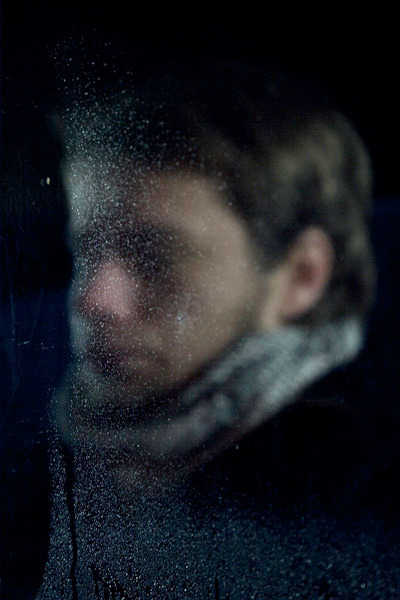
Image Reference
Keller, Dagmar./Wittwer, Martin. Passengers, #21. https://www.kellerwittwer.de/selected-works/passengers/
Passengers, #21 – This image to me makes me wonder what he is thinking, what emotions he is feeling and where he is going on this cold night. The black of the night makes the viewer focus on the subject directly and because there is ice on the window and the subject cannot be seen clearly, it makes the viewer use their imagination.
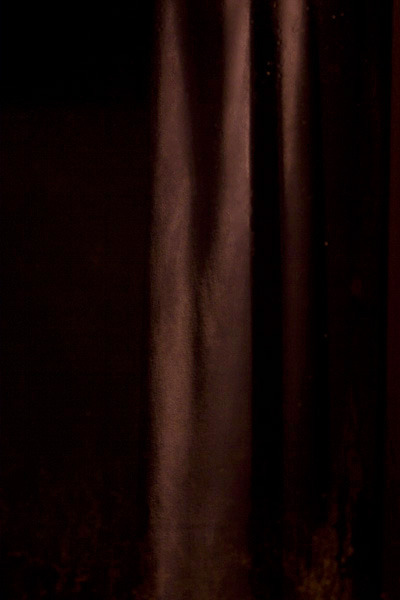
Image Reference
Keller, Dagmar./Wittwer, Martin. Passengers, #94. https://www.kellerwittwer.de/selected-works/passengers/
Passengers, # 94 – The photographers explored the surroundings of the bus stop. It appears to be a curtain but who knows where it is. I like the way the light hits the curtain and it may seem random in the context of all the other images, but it shows me the playful quality I am after as an influence to my own work.
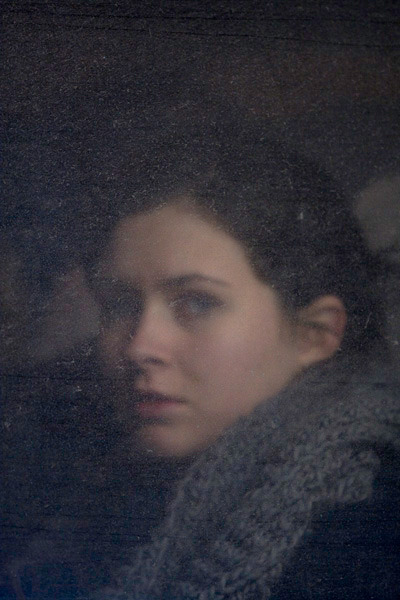
Image Reference
Keller, Dagmar./Wittwer, Martin. Passengers, #8. https://www.kellerwittwer.de/selected-works/passengers/
Passengers, #8 – This image is a bit clearer and looks like a painting. There is a look of pain in her eyes. Has she just left someone and catching a bus to get away? Is she regretful? Again it is in the imagination of the viewer.
Dagmar Keller and Martin Wittwer have collaborated since 1997 and their work includes photography, film and video. Their inspiration comes from urban social stories and the hopes and dreams of the people that live there.
References
Keller/Wittwer. “Selected works.” kellerwittwer. https://www.kellerwittwer.de/selected-works/passengers/
u-jazdowski. “Dagmar Keller & Martin Wittwer (Germany).” https://u-jazdowski.pl/en/programme/residencies/residents/archiwum-rezydentow/dagmar-keller-martin-wittwer
Rinko Kawauchi
Rinko Kawauchi was born in the early 1970’s in Japan and became interested in photography while studying graphic design. She has a very soft style of photography which she emphasises with soft colours. Her work and aesthetic is to have an almost dream like quality and will mostly shoot ordinary things.
Why her work is of interest to me is that she does not second guess herself and runs by instinct. If she feels compelled to photograph something, she will and not ask herself why. She rarely will include people in her images and is interested in images that move her rather than just look good.
She puts a lot of thought into her compositions and one of her main conventions is juxtaposition. She wants the viewer to imagine what is going on. She also commonly makes use of cropping and prefers to use natural light.
What I found interesting about Rinko is that she does not like to take multiple images and then select the best one later. She will purposely take her time and get the shot she had in mind.
References
Andia, Lucy. “ 10 Things You Should Know About Rinko Kawauchi.” Culture trip. 10 Things You Should Know About Rinko Kawauchi (theculturetrip.com)
Artsy. “Rinko Kawauchi.” https://www.artsy.net/artist/rinko-kawauchi
Ibasho. “rinko kawauchi.” Rinko Kawauchi - Overview | IBASHO (ibashogallery.com)

Image Reference
Kawauchi, Rinko. Halo. 2017. http://rinkokawauchi.com/works/172/
This image follows Rinko Kawauchi’s conventions of cropping and natural light. What I like about it is that it is off centre and the lighting gives it a dream like quality. I like the rule of thirds quality and the juxtaposition quality of the light shining from below where you would think it would come from the moon itself.

Image Reference
Kawauchi, Rinko. Halo. 2017. http://rinkokawauchi.com/works/172/
I like this image as you would expect there ordinarily to have some other feature to concentrate on but in this case it is just the birds. It feels very serene and makes me imagine what it must be like to be one of those birds. Me imagining this just highlights one of her aims which is to make people use their imaginations.
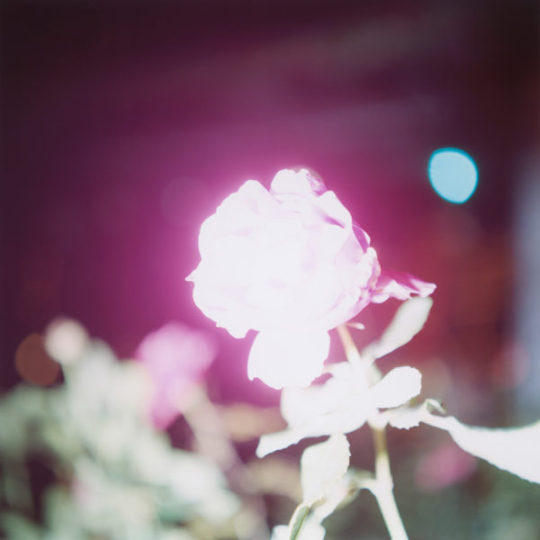
Image Reference
Kawauchi, Rinko. Illuminance. 2011. http://rinkokawauchi.com/works/194/
The use of depth of fielld and the overexposed lighting add a strange quality of beauty to this image.
Lieko Shiga
Born in Japan in 1980, Lieko Shiga has become a rising star in Japanese photography mainly due to her going against the grain of what other Japanese photographers do and being so expressive. What I find fascinating about her work is that she has no one particular style. She will integrate her own personal experiences and encounters into something surreal and she will do this by any conventions she can find including lighting tricks or double exposure of her images.
She is best known for her Spiral Coast project which was inspired when she was invited to become the towns photographer when she moved to a small community (Kitakama) in Japan. Her community was hit by a tsunami in 2011 and the town was flattened and over half the residents died.
Through her imagery, Shiga managed to capture not only the history of the village from before the tsunami, but also the spirit of the village. She cleverly did this by mainly shooting at night which gave the desired uncertainness. The images had a certain vagueness like it is a memory and she managed this by using a flash that does not reach the whole frame.
The deepest part of her work I find is her concept of photography itself. Shiga feels that photography is more than capturing a moment in time, Photography to her is not the past, present or future, but instead there is just space. There is no time. Shiga views herself as the camera as she bases most of her work on personal experiences. Photography therefore takes on a physical form. This is the sort of aesthetic I want to incorporate into my work. I want my camera to capture the qualities of what I see.
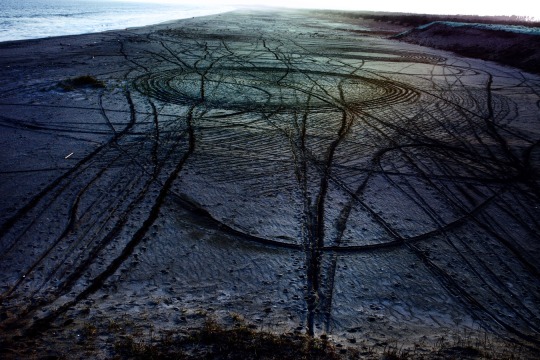
Image Reference
Shiga, Lieko. Blind Folded Pilot. 2012. https://www.liekoshiga.com/works/rasen-kaigan/
I love the texture of this image. You can almost image cars running up and down this beach and doing wheelies. What fun they must have had. After all, the beach is about fun. This is capture here. This would be my interpretation of this image but when you see the title Blind Folded Pilot it takes on another meaning. Now you can see someone lost and trying to find their way. Ironically this setting was staged by the photographer and she used a stick to make her patterns and lines.
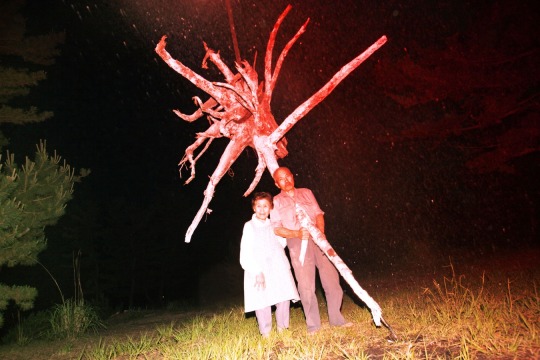
Image Reference
Shiga, Lieko. Portrait of Cultivation. 2012. https://www.liekoshiga.com/works/rasen-kaigan/
One of Lieko Shiga’s conventions is to place random items next to people she is photographing and this is an example of this. This image is of the chief to her village. Behind the subjects is a massive tree root and she Lieko would never admit how she did it but it appears as though the tree root passes through the body of the chief. the red colouring of the root and over the chief is of significance as well as it would symbolise the blood.
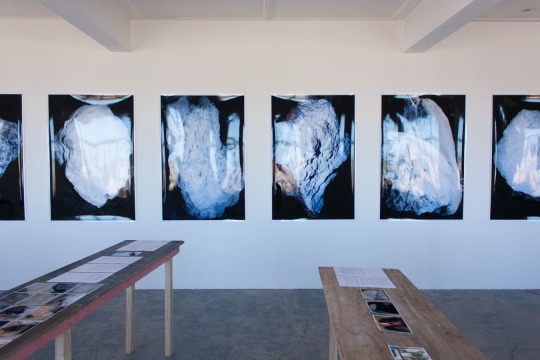

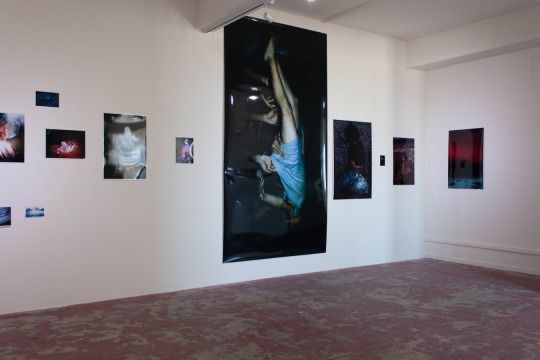
Image Reference
Shiga, Lieko. (Installation view). n.d. Photo credit Daegan Wells
How Lieko’s work has been exhibited in shows. I prefer the bottom image as this has visual diversity.
References
Artsy. “Lieko Shiga.” Lieko Shiga - 36 Artworks, Bio & Shows on Artsy
Badger, Gerry. “Lieko Shiga-RASEN KAIGAN/album (SPIRAL COAST/album).” 1000 words. https://www.1000wordsmag.com/lieko-shiga/
Maddox, Amanda. “A Japanese Photographer’s Encounters with Natural Disasters.” Aperture. https://aperture.org/editorial/lieko-shiga-amanda-maddox/
The Physics Room. “RASEN KAIGAN: THE SPIRAL SHORE.” http://www.physicsroom.org.nz/exhibitions/rasen-kaigan-the-spiral-shore
Irina Rozovsky
Irina was born in Russia in 1981 has exhibited work in galleries worldwide and now resides in Georgia, US. Her belief is that the camera is a third eye and believes a photograph can be taken anywhere and anytime. A lot of her work has been based around rootlessness, migration, diaspora and personal versus political freedom this was inspired mainly though her migrating from Russia to America when se was seven years old.
Ten years ago Irina was invited to a friend’s birthday party on the lake in Prospect park in Brooklyn. Irina had been to this park many times, but it was the first time on the lake. Looking back at the park from the boat she was on changed her perspective of the park and the people that visited it. It was as if the world stood still for her and she was compelled to begin a ten-year journey of photographing the people that frequented the park as the park covered many different areas of Brooklyn such as the wealthier side to the poor areas. There were people from all different cultures, religions, and ethnicities in different areas of the park and Irina spent the next 10 years visiting the park and taking photographs and she felt like she got something new and exciting every time she returned.
She spent her time discussing what she was doing with the people she was photographing, and subjects seemed to fully embrace her vision. She named her project In Plain Air and this has been an inspiration to my latest work. I have always tended to stage my photographs but what I want to do during this assessment is shoot my images in their natural form. The subjects do not need to be glamorous or use props that are in theme. I will find objects that are of interest to me and look for interesting ways to photograph them and in such a way that an otherwise dull and everyday object, can become interesting and a become a piece of art.
Irina Rozovsky I have noticed shoots from different angles which can change people’s perspective on issues. Her projects can run for varying times from a few weeks to several years and she will not move on until she feels she has captured the true essence of what she is there for. This to me shows the connection she has with the project and how she can run on instinct.
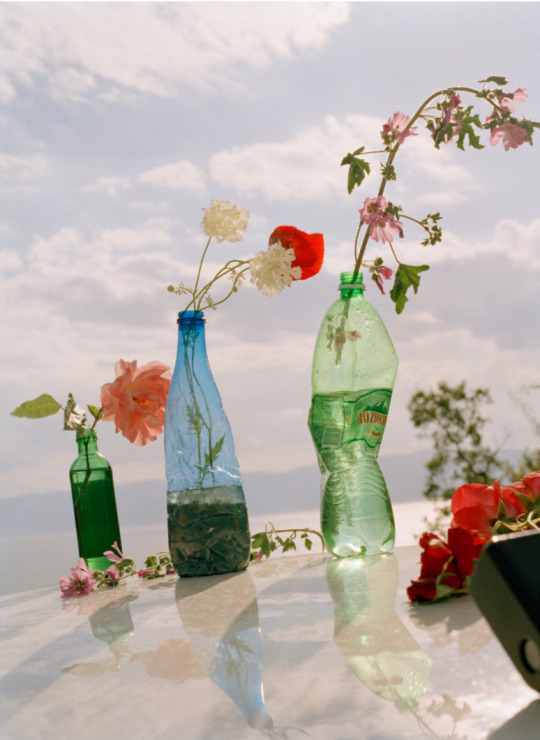
Image Reference
Rozovsky, Irina. Untitled, (from Mountain Black Heart). 2015-2016. https://www.irinar.com/mountain-black-heart
There are so many things I like about this image. I like the angle she has captured this from. I like how the reflection on the sand looks like glass. I like the irony of the flowers (as a living thing) are in plastic bottles which kill so many creatures in the sea. This is a statement that I’m sure she wants to get across.

Image Reference
Rozovsky, Irina. Untitled, (from Mountain Black Heart). 2015-2016. https://www.irinar.com/mountain-black-heart
The innocence of a child sleeping, oblivious to all the mess and turmoil going on around them. Whether this image was staged or not, the message is clear.

Image Reference
Rozovsky, Irina. Untitled, (from a rock that floats). 2014. https://www.irinar.com/a-rock-that-floats
Photographs made in the US, 2014 – present. Chromogenic color prints of various sizes.
I love the way the light reflects on the water and how it leads your eye to the buildings in the distance.


Image References
Rozovsky, Irina. Untitled (from In Plain Air). 2011-2016. https://www.irinar.com/in-plain-air
Capturing everyday life in Prospect park in Brooklyn where all walks of life occupy. Rozovsky liked to capture all people who visited the park which ranged from wealthy to the not so wealthy.
References
Feinstein, Jon. “PLACELESSNESS.” Daylight. Irina Rozovsky: The Politics of Placelessness | Daylight
Rozovsky, Irina. “The world in one park: Irina Rozovsky's best photograph.” The Guardian. The world in one park: Irina Rozovsky's best photograph | Photography | The Guardian
Syracuse University. “Irina Rozovsky.” https://calendar.syracuse.edu/events/2020-oct-20/irina-rozovsky/
3 notes
·
View notes
Text
I gotta say how much I love that this DC Limited Series is validating so many of my personal interpretations of existing canon. But of course, I'm talking about Blake — you know me.
I understand that many have difficulty with various inconsistencies in the art, but as someone who has read comics since age thirteen, I find them negligible Unless the company commissioning the series is wealthy, media tie-in comics are invariably slip-shod, with beginner artists and rushed art. Everyone's gotta start somewhere. I do accept the comics as canon and treat some scenes as the visual shorthand they are.
I really love many of the little details such as the Japanese aspects of her home life, along with the emphasis on Pacific Islander cultures, such as love of ocean sports — especially little Blake in a muumuu, draped with beaded necklaces. We also see she was a child in the city while Sienna is holding a rally with the Belladonna's both present and publicly acknowledged. Kali's dialog in a later issue tells us that Blake had fallen under Adam's influence when they still led the organization — so Blake was only eleven or twelve, at best. Clearly, younger Blake had periods where she was on the island. To me, that makes perfect sense, but to explain, I need to back up a little.
At odds with early fandom, I figured that Blake had to come from an upper class family and, if she were an orphan as her equivocation implied, then it was late enough in life that it left her with noticeably elegant manners. There was even a memorable instance in which Blake reflexively corrected Yang's slip in etiquette by thumping her across the stomach. (Just as Kali did to Ghira years later). From the way she holds a teacup to how mortified she was over Sun's behavior, we know manners matter to Blake. I was surprised as anyone else to discover her home still existed.
I was uncertain about her family home for a time until another viewer directed me to the post-episode storyboards. The house and lands are identified as "The Belladonna Estate" rather than, say, the chieftain's lodge. There is also a sepia toned photograph of what might be grandparents standing in front of what looks like the bungalow's portico. Finally we have V5's dialog about the Belladonna's time ending, which usually implies a family has been in power for generations.
The tragic princess story suggests that the island was already colonized by Faunus before Humans "gave" it to them. It's far more plausible, from a real life historical perspective, that Humans found the land inhospitable, full of dangerous wildlife and, most salient, resource poor. After the Faunus uprising, the people of the island welcomed refugees and those emigrating from Human controlled lands. The "gifting" was an underhanded way for Human's to cede authority and agree not to invade. So either the Belladonna's were native (unlikely since the capital name suggests a different culture), or they were Mistrali who married into a ruling family.
A chieftain system like we see in Kuo Kuana mostly closely resembles a constitutional monarchy. In smaller villages or tribes, the ruling body might be a council of elders. In a sprawling Rio de Janeiro city like Kuo Kuana, which stretches across the entire valley, it's likely a set of government department heads. The chieftain acts as a figurehead where compromise and mutual support are desired, but not necessary.
That person also forms alliances with other groups/governments and spearheads trade negotiations. In this system, the chieftain doesn't need to be present for the government to continue running smoothly. This system is completely compatible with the Chieftain of Kuo Kuana serving as High Leader and spearheading long-distance political rallies.
Blake refers to the early White Fang environment as being like a family, which kind of implies entire family groups were involved. But they were not a band of Roma or Sinti refugees continuously fleeing Nazi's and denied settlement everywhere they went (and still are). The way I see it, the WF were essentially a missionary group. Anywhere they went holding rallies, giving speeches, rocking the boat, they would have attracted converts and followers. They would have collected refugees, the elderly, the disabled, children, homeless, all wanting to flee and find new homes. Everyone needed to be fed, clothed, protected from Grimm etc.
There is no way that WF traveled through the winter — that would have been an unnecessary logistical nightmare, and suicidal for family groups. Instead, I imagine the Belladonna's gathered resources, planned travel destinations, organized funding, volunteers and everything else during the northern hemisphere's winter, while back home in Kuo Kuana. The band would then travel from spring to winter, which would be consistent with Blake's claim that she spent most of her life traveling with the WF. Then they would bring everyone back to Kuo Kuana in the fall, get new immigrants settled and so forth.
Let's go back to all those kids. First, the notion that semi nomadic groups don't educate their children in all aspects of life is an example of internalized racism with its roots in colonialist beliefs. All societies educate their children, but prior to the western colonial era, schools took a variety of forms. Some were permanent structures, some were tents, some were a circle of seats in an open clearing.
The materials might be written or oral, the teachers might be scholars, philosophers, priests or rabbi. In older models of education, you might think of it as elementary schooling followed by vocational training that inherently included relevant high school level topics. Regardless of method, the WF's children weren't a bunch of uncouth illiterate wild animals, though I'm sure Remnant's Humans believe exactly that.
Blake's vocational training would have been to a government position — more or less. That would have been history, politics and diplomacy, public speaking, combat abilities (for social appeal and to avoid being assassinated for power), self-restraint and etiquette. Much of that training would have begun when she was very little — some of it occurring subconsciously because little kids are like social sponges. But imagine truly comprehending that as you hit your early teens, that an entire island population will depend on you (even if only as a figurehead).
That is what brings us to the royalty in disguise trope. The most familiar example is Aragorn from LoTR. This trope always begins with the young royal attempting to abdicate from an overwhelming social responsibility, which haunts them whether they choose to go solo, follow another leader instead, or become a hermit. That guilt underpins their actions until they ultimately accept their role in society.
TL;DR; The White Fang did missionary work most of the year, helped new immigrants and planned for next year during the winter, and educated their children the same as any other society does. Blake spent about an aggregate third of her childhood at the family estate before Ghira became Chieftain full time, after which Blake traveled year round with Adam's splinter group. Her original very carefully worded equivocation was true and we're just having the six years of fanon problem.
241 notes
·
View notes